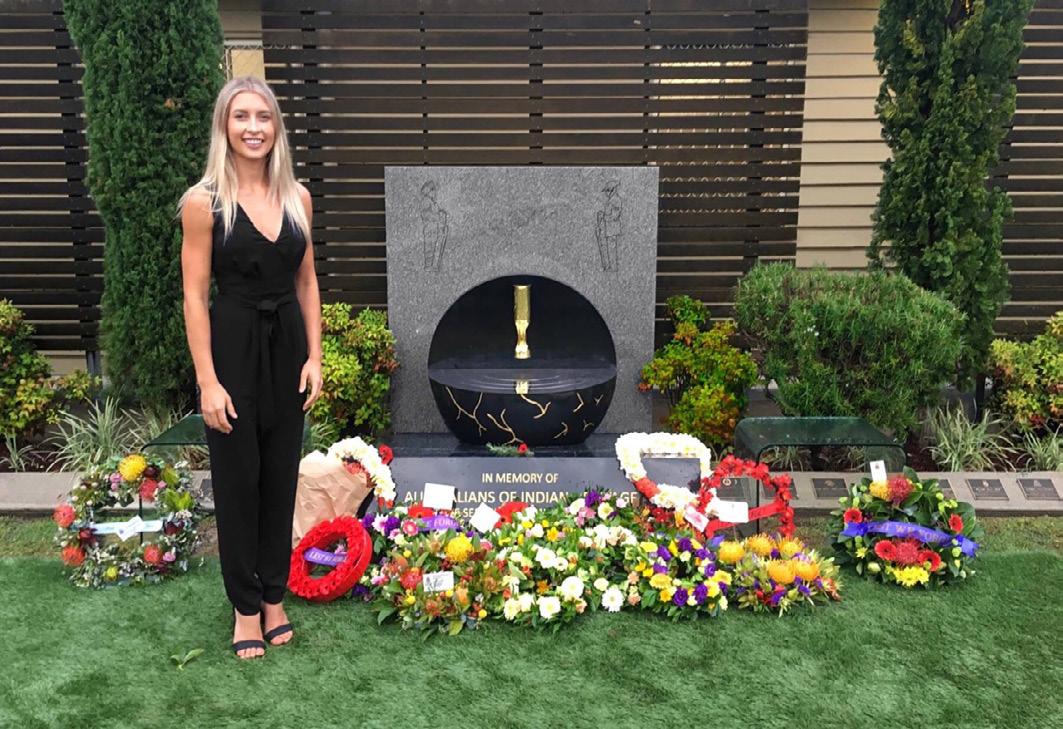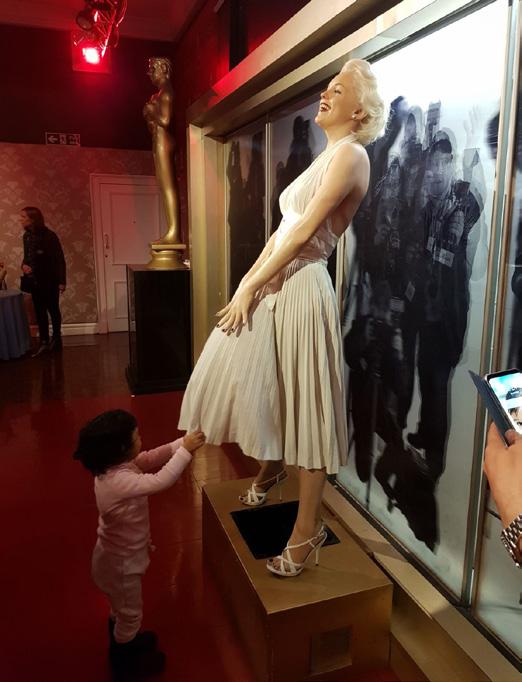


FREE DECEMBER 2017 • info@indianlink.com.au • www.indianlink.com.au PERTH SYDNEY MELBOURNE ADELAIDE BRISBANE PERTH CANBERRA Level 24/44 Market St, Sydney 2000 | GPO Box 108, Sydney 2001 | Ph: 18000 15 8 47 | email: info@indianlink.com.au WINNER OF 21 MULTICULTURAL MEDIA AWARDS Forum for Indian Australians Indians in Sydney Indian Mums Connect (SydNEY) Melbourne Indian Community DESI REFERRAL NETWORK Indians IN Perth riends in deed
Heron Park is a multi-award winning estate, designed for the best in vibrant and well-connected masterplanned living.
• Easy access to the city and Fremantle
• Landscaped family parks and walkways
• Over 1,400 homesites available




State-of-the-art primary school and $61million Harrisdale High School are within the estate.
• Nearby national parks and reserves
• $51million Harrisdale Shopping Centre

• Play hard with golf, soccer, tennis and horse riding facilities nearby
• Developed by Satterley – 37 years of award-winning communities




LAND from $220,000
HOUSE & LAND from $368,890
choice
Canning Vale Markets 27 minutes to Perth CBD to everything Picture the convenience of being so close
The smarter
Make the smarter choice at Heron Park. heronpark.com.au/oriental
INDIAN LINK
PUBLISHER
Pawan Luthra
EDITOR
Rajni Anand Luthra
ASSISTANT EDITOR
Harshad Pandharipande
MELBOURNE COORDINATOR


Preeti Jabbal
CONTRIBUTORS
2017: The year the US lost its mojo
violence shows no signs of slowing down.
ADVERTISING
WA Sales Manager
Ram Naidu 0435 581 571
National Sales
Vivek Trivedi 02 9262 1766
Advertising Assistant Charuta Joshi 02 9279 2004

Indian Link is a fortnightly newspaper published in English. No material, including advertisements designed by Indian Link, may be reproduced in part or in whole without the written consent of the editor. Opinions carried in Indian Link are those of the writers and not necessarily endorsed by Indian Link. All correspondence should be addressed to Indian Link
Level 24/44 Market St, Sydney 2000 or GPO Box 108, Sydney 2001
Ph: 02 9279-2004 Fax: 02 9279-2005
Email: info@indianlink.com.au
 BY PAWAN LUTHRA
BY PAWAN LUTHRA
Donald Trump was sworn in as the 45th President of the United States of America in January this year. His elevation to the top job, and actions in it, have taken the world by surprise - to put it lightly. Known for his “bombastic” style of management, with more experience in reality TV than tactful diplomacy, Trump has set the United States down a path where it may face difficulty in maintaining its global leadership on a wide variety of issues.
Twice already this century, the US has been at war: first in Afghanistan in 2001, in retaliation to the terrorist attacks on US soil, and the follow-up, the 2003 war against Iraq, which has been seen by those who should know as unwanted and wrong. Not only has this war cost US taxpayers over $2 trillion, but more significantly, thousands of lives have been lost. With a proxy war in Syria looming, this propensity for
Trump burst onto the international scene in a year when the Nobel Peace Prize was awarded to the International Campaign to Abolish Nuclear Weapons, a group that works to promote nuclear disarmament around the world. And yet, under Trump, the possibility of a nuclear war with North Korea has increased exponentially, and the long-standing nuclear deal between US and Iran faces the likelihood of standing no more. In the Qatar-Saudi Arabia diplomatic rift, while Trump’s Secretary of State Rex Tillerson attempted to bring about reconciliation, the President himself lauded the Saudis for their “hard but necessary” move. Under his leadership, the US appears more content with confrontation rather than negotiation. His latest announcement of recognising Jerusalem as Israel’s capital has been rebuked by almost all the international leaders, including the UK Prime Minister, the Turkish President, the French President, the Saudi King and even the Pope.
President Trump has blasted the United Nations, semantically criticising them as “not a friend of democracy… not a friend to freedom…not a friend to
the USA” and withdrawing his country from UNESCO. Subsequently, while the US has been acting like a bull in a china shop, China is increasingly seen around the world as a power to be dealt with - extending to its rivals an economic embrace through its One Belt, One Road policy, meeting international environment preservation targets, and creating alliances with Russia to increase its influence in the World Trade Organisation. Why is this important?
With economic might comes the ability to influence other geo-political situations, as one nation (and one nation only) sees fit. China is Africa’s largest trading partner and experts believe that Africa carries an enormous diplomatic weight in shifting the political influence away from a US- and a Western-worlddominated world order.
Without question, the United States’ mojo has diminished in the first year of Trump’s presidency, and with three years before the next election, its influence seems to be heading in only one direction. What India must do in response, is adjust its global aspirations - caught politically, diplomatically, at times ethically and of course geographically, between these two giants.

DECEMBER 2017 3 INDIAN LINK editorial
Uma Nair, Grahak Cunningham, Tarini Puri, Aparna Ananthuni, Dipanjali Rao, Puneet Anand, Saket Suman, Priyanka Tater, Vikas Datta, Vandana G, Nury Vittachi
NOT QUITE A ‘DEMON’?
APARAJITA GUPTA’s piece questioning the efficacy of India’s demonetisation drew some sharp reactions

Raghbjha wrote: This is a highly one-sided article that chooses to portray what it wants to portray and ignores the rest. So, all the data on the amount of suspicious deposits in some bank accounts, the number of shell companies closed, the ease of passage to the GST and many others are all irrelevant, according to the author of this article. Also, the article chooses to ignore the fact that the government prepared the economy for the demonetisation through opening up of Jan Dhan accounts and giving tax dodgers a chance to come clean. All this happened before demonetisation. The appropriate counterfactual for assessing the impact on economic growth is what the growth would have been had there been no demonetisation - not the actual rate of economic growth. In any case, growth picked up after one quarter of decline. Future growth will be faster, cleaner and more sustainable and inclusive.
Prakash Mehta wrote: This is a biased article on demonetisation in India due to many reasons. First, ordinary people had several opportunities to open up bank accounts (including Jan Dhan accounts) in which they could deposit their old currency notes. Second, those who had dodged taxes were given a generous opportunity to come clean, declare their assets, pay their dues and become part of the legitimate economy. Hence, the only people whose wealth positions were adversely affected by demonetisation were the dishonest. Others were affected only temporarily and to the extent that they had to stand in queue to withdraw cash and/or deposit money. Second, black money in the Indian economy has come down substantially. More than 300,000 shell companies that were being used for money laundering have been closed. Hundreds of thousands of suspicious deposits into bank accounts have been identified and will be pursued. A strong benami law and a regulatory authority for real estate are functional. Third, the tax base of the economy has gone up sharply as numbers of both direct and indirect tax payers have gone up. This will enable the government to spend more on health, education and infrastructure, among other things. Fourth, digitisation of the economy has rapidly expanded.
Fifth, the shrinking of the informal economy has meant that the country could adopt the GST which has led to the creation of a unified Indian market for the first time since Independence.
WHO WORE IT BETTER?
We asked who looked better in the Delpozo dress, Hillary Swank or Sonam Kapoor?
Vishal Gupta
wrote: Dress ki bhi gharwapsi ho gayi… from hot to sanskari
YOUR SAY SAY IT AGAIN
USHA RAMANUJAM ARVIND’s article on Pink Sari Inc winning at the Australian Multicultural Marketing Awards won praise from the woman behind the organisation

Shantha Viswanathan wrote: Thanks, Indian Link, for the great coverage as always! Usha has put together all our comments and so articulately conveyed our message in her article. Besides the community, the media has played a key role in spreading the Pink Sari message since its inception. On behalf of Pink Sari Inc, I would like to convey our sincere appreciation for your ongoing support and for your personal interest in what we do.
KINDNESS FLOWS, FROM ADELAIDE TO RAJASTHAN
The University of Adelaide crowdfunded a project to produce low-cost water purification kits, reported TARINI PURI University of Adelaide wrote: Thanks for your interest in this, we appreciate it.

Deepika Bharti wrote: Thank you for your support. The University of Adelaide research team has reached their target and are going ahead with their water filtration project in Rajasthan. I am sure every bit would have counted.
WHO WORE IT BETTER?
We asked who rocked the Stella McCartney dress more - Deepika Padukone or Gwyneth Paltrow? The winner was clear Meenakshi Seetharaman wrote: Hands down Deepika Padukone! She looks stunning!



Sylvia cc wrote: Deepika, the colour of her dress suits her better Dipti Desai wrote: Of course, Deepika, the Indian beauty.

Ishani Shah wrote: Indian beauty, Deepika Padukone!
Priyanka Chopra’s stand against Trump’s migration restrictions was impressive and again she is on an inspirational ride MasterChef Australia judge Matt Preston

In shock at reading what my dear friend is going through. Deepika you are one of the strongest women I know Actress Ruby Rose on Padmavati controversy

4 DECEMBER 2017 www.indianlink.com.au
WHAT’S ON RANVEER-DEEPIKA’S MIND?
We were flooded with responses on this caption contest we ran a few days ago. Here’s a selection
Namita Sheregar wrote: Ranveer: Paani se bachao deepika..
Deepika: Chup raho mera camere se focus hat jayega
Arti Asthana wrote: Let’s create the same magic with Padmavati as well.....fingers crossed
Rani RJ wrote: Let’s enjoy the calm before the storm.
Khem Raj Kharel had this to say: Deepika: Quick Ranveer! Act evil, we are trying to promote Padmavati here...
Ranveer: Im trying my best here Deepika, but your perfume smells so good, can I hug you?
Deepika: Maybe you should stick to romantic movies Ranveer...wait so that’s why you wanted us to dress like Bajirao and Mastani?!
Anshul Kothari guessed: Pakde Rehna, Chhodna Nahi.
Gaurav Wadekar wrote: Deepika: How is it that we fall into Sanjay’s trap again and again?
Dahlia Ahmed wrote: We love each other and we are together no matter what other people think. We are meant for each other.
Lakshman Kumar wrote: When the public can accept a movie on Akbar, why can’t they accept this movie? Padmavati, request them with your magical eyes.

THE LABOUR PAINS OF ADOPTION
Liz and Adam Brook haven’t been able to adopt a child from India, thanks to a freeze on inter-country adoption, wrote RITAM MITRA

A reader wishing to stay anonymous wrote: When we passed through the phase of adoption, no one can understand what we went through every moment, waiting for a phone call, snubbed off rudely by both Australian and Indian red tape and bureaucracy…tears, trials and tribulations. I feel very happy that Ritam has put all this together. I feel so privileged that by a very thin line, we have our daughter in our lives. We feel grateful and must have done some little good in the past or present to be able to have her in our lives, but equally we feel helpless for others who are victims of this limbo. A big heartfelt congratulations to Ritam for working on this bit which is so close to my heart, and hope it will be valuable information for all wishing to go down that line for starting a family.
Rajni Luthra commented: Wishing you all the best in your quest, Liz and Adam.
Liz Brook shared the article in her network and received plenty of encouragement
Yan Hope wrote: Good things come to those who wait (And wait. And wait…)

Michelle Forbes wrote: I will keep my fingers crossed for you both. Sending love and hugs your way.
Elaine Brook wrote: Never give up! There must be someone in the authority who could help your cause. Thank you Liz and Adam for putting it out there. All the best. Hope you succeed before too long.
Jessical McNeill wrote: Such a sh**ty situation. Hope this story goes a long way in raising awareness and driving change.
Debbie Purtell wrote: Thanks to Indian Link. A good, informative article. Nisha Prichard wrote: Great awareness raising. Keeping fingers crossed for you guys.
DESTIGMATISING DEMENTIA
NANDITHA SURESH wrote about the first-of-its-kind support group launched for Indian-Australians
HOW NOT TO ORGANISE A PUBLIC PROTEST
The way the senior Indian diplomat was cornered at a Melbourne gurdwara recently left the community shaking its head in disbelief, wrote RAJNI

ANAND LUTHRA
Ashish Chawla wrote: The way they speak to the High Commissioner is a disgrace!
Varun Pal wrote: I found it appalling to say the least. Surely, there are better ways to put your point forward. Respect the High Commissioner. There are channels through which you can raise the issues. The slogans towards the end were uncalled for as well.
INDIAN TEEN WITH DISABILITY WINS AWARD
DHANYA SAMUEL wrote about the inspiring story of how young Mark Alvares put aside his challenges and embraced life.
Mythili Iyer applauded: Kudos to Mark Alvares for his resilience and positivity. May he find more success in his new challenges ahead.
Jayanthi Vellore said: Well done Mark! You have been an inspiration to all of us.
Nankana wrote: The need is real hands on support to the dementia patients and their carers and families. Mere forums and seminars are just to create awareness among the community. Need is to take the next step to give or obtain for them the direct assistance and give social support and volunteer help. There are several persons who have recently sprung up in Indian community and it has become fashionable to start charity or community service groups, with the individual promoting themselves and just collecting funds. Community must become more demanding and selective in supporting such attention seeking self-serving persons who are merely exploiting community and such patients and families.
Some such organisations, whose objectives do not even mention Dementia or mental health or old-age services, are also jumping on the dementia bandwagon to gain on the attention it is getting. They are not doing any good in this field. They must keep away and stick to their declared objectives not to dilute the resources and attention.
Please do not exploit those already suffering from the problems, which is already causing much problems and damage to such sufferers and confusing the community, as to who is the right organisation.
+ JOIN THE CONVERSATION
> LOG on to your own Facebook or Twitter account
> TYPE “Indian Link” into the search box at the top of the screen and click on the link that comes up
> CLICK ‘Like’ to join the Indian Link Facebook community or ‘Follow’ @Indian_Link on Twitter

DECEMBER 2017 5 INDIAN LINK
Friends in deed
There for each other
BY HARSHAD PANDHARIPANDE
You’re not alone. We’re with you. That’s the sentiment, repeated over and over by hundreds of apparent strangers, that has kept Vikramjeet Singh going these last few days.
Scrambling to arrange funds for his visiting mother’s medical treatment and with very few people to turn to, Granville resident Vikramjeet - who moved to Australia just over a year ago - made an impassioned appeal on the 27,000-member-strong Indians In Sydney group (IIS) on Facebook.

How the community responded over the next few hours and days was part heroic, part human and deeply touching.
First came financial help (Vikramjeet had received $4,000 before the day was up), then advice (using which Vikramjeet set up a GoFundMe page) and then a lot of initiative (people tweeted out Vikramjeet’s story, tagging India’s External Affairs Minister Sushma Swaraj, the Indian Consulate, and the Indian insurance firm whose cover Vikramjeet’s mother had bought).
The result? A representative of India’s Ministry of External Affairs, visited Vikramjeet on 4 December, promising help. By 5 December, Vikramjeet’s GoFundMe page had raised over $65,000.
It is just the latest illustration of how migrants, both old and new, are finding solace and support from online communitiessuch as IIS. From desperate pleas for job opportunities, questions about visas and travel advice to restaurant reviews and shopping recommendations (and the occasional forwarded joke or three), the groups are the whole spectrum of human emotion on display.
The groups are also a fairly accurate representation of what the diaspora is talking about and thinking about. They offer an insight into the community’s aspirations and ambitions, its fears and frustrations, its hilarity and heartbreaks.
They are also an embodiment of Indians’ intrinsic unity but also, at times, their inevitable fault lines of regional and linguistic differences and political persuasions.
But despite this, and due to the spike in migration numbers in the last three years or so, the groups have become both increasingly populated and increasingly popular. For the typical FOB, they serve as an all-you-wanted-to-know-but-didn’tknow-whom-to-ask forum, with old-timers dispensing advice with avuncular patience.
And in these collaborative communities, some truly heart-warming stories have emerged of how the group members have come together to help each other out.
So, for instance, a new migrant who faced a last-minute glitch in his accommodation arrangements posted a message on the group, saying that he couldn’t afford to buy a mattress and asked if anyone had a spare.
Not only did people come forward, some even offered to drive to his place and drop it off themselves!
Then there was the time when the members came forward in aid of a fellow IISian (that’s what they call themselves) who sought a bicycle and a mobile phone to help him work as a food delivery person. One member who lives in Perth but was flying to Sydney that night offered to meet the creator of the post, Saiprasad, and buy him a bicycle. Several others wrote in, offering their old mobile phone. Some others asked Saiprasad to send them his CV so they could help him find a job related to his field, IT.
Advice and opinions
Even when it is not about material goods, the group has plenty of advice and moral support - sometimes a kind word is all you need - for several other queries.
Many posts are about the biggest concern of new migrants: finding a way to crack into the competitive job market. On every desperate post asking for a job - any jobthere are invariably several members who ask for the CV to be sent to them. Others who can’t help directly always have words of encouragement, general advice and tips and suggestions to make the CV more relevant.
Visa categories and subcategories can confuse the best of us, but trust the resident experts (or MARA agents) to bring clarity on the issue.
And then there are posts about the more mundane - but equally important - things. Things such as ‘What food items can I bring to Australia?’, ‘What’s the best way to transfer money to/from a bank account
in India?’, ‘Which is the best private health insurance?’, ‘Passport expiring soon, what to do now?’, ‘Which centre is best to clear driving test?’ and so on.
There was one post that even talked about how toilet paper doesn’t offer the same kind of, er, satisfaction as water. While many said they found the post utterly relatable, others quickly pointed to many options - jet sprays, bidets, and ‘lota by the railway tracks!’
All about helping fellow members

But whether the topic is lofty or lowly, help is always around the corner. For someone who has arrived in Australia, leaving their comfort zone, social circle and family behind, the group is the new family and safety net. Which is the point of the whole group, its credo, says Nadeem Ahmed, the group’s founder.
An IT professional, he moved to Australia in 2006 and found that there was no one to answer questions about where to find apartments, look for jobs, what documents to carry to get a driver’s licence and many other issues. “I spent a lot of time looking for that kind of information but it was hard to come by. I realised there must be many people in a similar situation. So I thought of forming this group to help members share information and knowledge,” he says. Ahmed added that the group had grown steadily over the years, but the last three years have seen a rapid increase.
“The main aim is to help our fellow Indians. We have all come here to >

6 DECEMBER 2017 www.indianlink.com.au
cover story
Rather than becoming forums for self-glorification, online groups have become dynamic communities that care for fellow members and make a difference in real life
Vikramjeet Singh with his mum
> Australia, away from our comfort zone, and have each other to rely on. That’s what binds us together,” he says, adding that helping others ‘feels great.’
In fact, studies show that online interactions have positive outcomes for real-life, place-based communities, but the intersection between online communication and the offline world also forms two halves of a support mechanism for communities.
A report by Illinois News Bureau quotes a research by Caroline Haythornthwaite and Lori Kendall, professors in the Graduate School of Library and Information Science at Illinois, says, “From social networking, to civic participation, to community support during emergencies, to providing on-theground information in disaster areas, the professors say that the rapid development and widespread use of online technologies - for communicating and networking, for contributing and distributing content, and for storing, sharing and retrieving files - are creating ties that bind for offline communities.”
Concerted action for Vikramjeet

Which brings us back to Vikramjeet Singh’s case. The group’s conversation has been dominated by it ever since Vikramjeet’s first appeal for help on 28 November.
The group’s action has been a model of concerted action, with many members making the cause their own. “Irrespective of faith, background, language, we all came together to support him,” Ahmed says.
One such member was Gagan Bindra, who tweeted about Vikramjeet’s case and tagged India’s Ministry of External Affairs and its minister Sushma Swaraj.

A firefighter, Bindra is no stranger to helping people out. “When I saw Vikramjeet’s post, I knew I had to do
something,” he says, adding that he started by creating his Twitter account for the first time and tweeting to Swaraj because she is a ‘good lady whose ministry helps Indians in dire situations overseas.’
He says he was moved to act because ‘it could have been my mum.’ “Hundreds of parents come to visit their children here and take Indian insurance, but if the company doesn’t pay, then it’s no use. So, I also wrote to Religare, whose insurance Vikramjeet’s mother had,” Bindra said.
The company later tweeted, saying that it had ‘noted the concern’ and was looking into the case. The Indian consulate also responded with a message.
Bindra said he was glad his tweet had worked and was glad that the community had come together for a common cause. “Most
RETURNING PURSE, WITH GROUP’S HELP >
In July, banking professional Mayank Jain won praise after he helped return a purse containing bank cards and about $600 to a woman who had forgotten it on a train.

After finding the purse, Mayank wrote a post on Indians
In Sydney, asking what he should do.
In no time, Mayank got a string of suggestions that ranged from contacting the bank, handing over the wallet to the train station manager and approaching the police. He chose the last option.
“I went to Riverstone police station and handed over the wallet to them,” he said. Mayank kept updating the Facebook post about how he was going about returning the purse. Those who saw the post heaped him with praise. One person shared how they had also recently found a purse and returned it after tracing its owner through Facebook.
Then, around 10 pm on the same day, Mayank got a call from the police, saying that they had located the owner of the purse. “The policeman told me that scheduled to fly overseas the next day and had been saving the money to buy her husband a present,” he said.
“Good job, mate. Keep up the good work,” said a commentator on IIS.
“Imaandari zinda hai (honesty is alive). Proud of you, Mayank,” added another. Mayank, 37, however shrugged it off, saying what he did wasn’t ‘a big deal.’ “I have been a student, so I know how hard saving money is. I just did what I thought was the right thing to do,” he said. As the group members thanked Mayank for restoring their faith in humanity, one person summed it up, saying, “If my wallet ever gets lost, I hope you are the one who finds it!”
of us are first-generation migrants. We are far away from our motherland and that is what binds us together. We can put ourselves in others’ shoes and have sympathy for each other. We help rather than trying to pull each other down,” he said.
True enough, many retweeted and shared Bindra’s tweet, a factor that undoubtedly prodded the authorities to act. Each step forward - financial milestones, insurance
company taking note, Indian authorities promising to act - was posted on the group. Vikramjeet, on his part, was grateful too.
“First, I thought I was all alone,” he said. “But now I feel the whole world is standing behind me.”
No wonder then, that the group members were excited about the impact the campaign had had. “Great effort from everyone,” a member commented. “Unity rocks.”
FERRYING PARENTS, MEDICINES, GOODS >
In October, a group member Vicky Vikas posted a message on the group, saying that he was travelling to India and would be willing to help anyone with ‘parents, medicines etc.’


It was a simple enough post, but the spirit behind it left members applauding Vikas.
Many people from the group sent him requests to carry some goods. As Vikas responded to the comments, one member asked him why he was doing this. “The group helped me when I was in need of medicines for my mom,” Vikas wrote. “Just wanted to return the favour.”
In fact, there are many posts on the group asking fellow members if they would be willing to accompany ageing parents from India to Australia or back. For many, asking members on
social media groups to be travel companions to their senior mum or dad is quickly becoming something of a standard practice.
Often enough, someone responds, either by volunteering to be the seniors’ companion or giving helpful advice, for instance, which airline to take so that the parents would be well taken care of.
Requests to bring medicines - again, mostly for parents or other visiting seniors in the family - are also fairly common. Some months ago, Neer Vish was coming back to Australia from India and asked the group members if he could help bring some stuff over.
While he did get a few requests, it was his gesture that won him praise. “It’s no big deal,” Vish explained in a comment. “I may need help in the future so just paying it forward.”
DECEMBER 2017 7 INDIAN LINK
Nadeem Ahmed
Mayank Jain
Neer Vish Vicky Vikas
COMMUNITIES FOR JOB ASPIRANTS >
Browse long enough through any Facebook group about recent migrants and you are bound to come across posts from people looking for a way to crack into the job market. Many of these posts betray a sense of urgency, desperation, and, in some cases, downright alarm: new migrants running out of savings from India with no job in sight in Australia. The financial situation may not be dire for others, but it is certainly frustrating as they face rejection after rejection.
Desi Referral Network is one such community that has thrown the veritable lifeline to quite a few such people. With advice about tailoring one’s CV for the Australian market, job hunt and networking strategies and job postings as well, it is a great resource for new arrivals and job aspirants.
One recent post on the group was by a member who had got a job after threeand-a-half months of struggle during which they claimed to have sent out over 600 CVs to potential employers. “This was the toughest time of my life and I want to
assure all of you who are struggling right now that you will get a job in your field. It’s just a matter of time.”
Another member posted that they were about to give up, ‘although I couldn’t afford to give up,’ when they came across the group. “It really gave me instant energy, giving hope that this is going to work,” they said, adding that they got information about a job vacancy and a reference. This finally helped the member land a job.
Gaurav Wadekar knows this drill all too well. A business analyst himself, he also runs a meetup group for new migrants and job seekers, although not particularly from India.

“I thought I was good at my business analysis skills, so started a meetup called Australian Business Analysts in June. Four people came, all looking for jobs. That’s when I realised there would be many such people, so I started the meetup called Finding A Job In Australia,” Gaurav said.

He said he started getting calls from people saying they hadn’t been getting
WHEN INDIAN MUMS CONNECT >
If you are an Indian-origin mum living in Australia, you’re most likely a part of an ‘Indian Mums’ Facebook page (Indian Mums Connect, IMC Sydney, IMC Brisbane, IMC Gold Coast, Desi Mums in West Melbourne, Connecting Indian Mums Melbourne).

You’ve no doubt marvelled at the information disseminated on these pages, and have most probably been motivated to contribute yourself.
As information and communication platforms, these vibrant pages are fast becoming the go-to place for your queries, indispensable particularly for new migrants. A wide variety of topics are discussed. “Eggless cakes” are a recurring theme for some reason, but so are women’s health issues, babies’ and childrens’ health matters, hot-housing of primary school kids (online resources for maths practice? Hindi lessons? Martial arts?) contraception-related matters (where can I get a morning-after pill?), house help, travel advice, even advice on interfering in-laws and recommendations for divorce lawyers. The suggestions pour
in in a matter of hours, sometimes minutes. With the quantity and quality of knowledge contributed, it is becoming a valuable support mechanism as we negotiate the demands of our fast-paced lives. Electronic word-of-mouth, you can say, does wonders.
One brave young woman is currently vlogging her way through her cancer treatment - and to see the massive outpouring of love and concern and prayers and virtual hugs from the online community, can only raise your faith in humankind.
True, the advice can sometimes be inauthentic (beware of migration advice from non-professionals, or medical issues dealt with in outlandish suggestions from alternative therapies such as “Skin rash? Apply chandan”). But overall, the users have themselves stated more than once, the groups are “better than Google.”
Clearly, Facebook can be more than “look at how much fun I am having.”
It can help reinforce local relationships, and indirectly, local identities. Rather
interview calls. “I looked at their resumés, helped them align their skills with the job requirements, gave them networking and interview strategies. I have been able to place about 15 people in the last four months,” he said, adding that while most of the jobs have been in IT, others have been in financial services, retail and construction.
“There is no one-size-fits-all approach. I have to research for each sector to see what kind of opportunities are available. I also speak to the people who approach me to analyse what skills they have, what kind of experience they have, what their present circumstances are. So, it’s a very tailored strategy,” he said.
While most of Gaurav’s work is face-toface with a candidate, the initial contact is often on, or because of, the online meetup group that he has created.
The group also organises monthly meetups in which guest speakers talk on a relevant topic (how to write a resumé and cover letter, networking tips and so on) and where one can meet fellow job seekers and exchange notes.
Of course, there are many who still struggle to find jobs after moving to
Australia. This phase of uncertainty can stretch for months, and it’s easy to fall down the pit of hopelessness. For such people, the group can be a job referral network, or at least an agony aunt. And then there are those who finally land a job, and immediately write a post on the group, detailing their journey and urging others not to give up. One such recent post by Harshad Barge touched the hearts of many.
Barge detailed how he worked casual jobs and struggled to do any kind of saving, but kept at it to pay rent. “All the while I was applying for jobs but all I was getting was either silence or rejections. Then family arrived. Had to work more to sustain all financially. Took up casual roles. After a 1 year, 1 month 5 days, got a dream job again. Just don’t give up. Keep swimming. For those who think of going home, keep swimming the shore is there.”
The post tugged at more than a few heart strings. “Not everyone can share their struggle story but trust me everyone has one! Good to share, hope these words can inspire someone not to quit!” said one comment. “You would have inspired at least a few strugglers for sure,” added another.
than one-on-one or even small group communication, experts call this a kind of “whole community communication” that results in binding ties in a manner that longstanding community ‘associations’ have not been able to foster.
Of course, online communities are not without their limitations. As members
continue to communicate with their own ‘type’, they run the risk of limiting their exposure to new people and new ideas. But for the moment at least, in our own community, this growing social trend is becoming vital infrastructure, as members connect away online.
Rajni Anand Luthra
8 DECEMBER 2017 www.indianlink.com.au
coverstory
Finding A Job In Australia meetup Gaurav Wadekar
The dangers of citizen journalism
Having spent the better part of the week working on a story on the wonders of social media in building caring online communities with real benefits for members, this one comes as a bit of a shocker.
You’ve all seen by now the disturbing video of a school team of Indian hockey players currently in Australia. As they missed their match second day in a rowthanks to poor coordination, or indeed a complete lack of it - they spoke on camera about their situation. The video went viral, and left viewers quite distressed.

It was, of course, all sorted out, with the local community as well as Indian government agencies chipping in.
But the damage was done: the interviewer, who claimed he was a taxi driver, clearly showed the distress of the girls in a manner that was disquieting, and tut-tutted about the ‘Indian government’s apathy for women’s sport.’
The sensationalist and alarmist nature of the video, including accusations being made with no absolute proof, is evidence for the dangers of citizen journalism.
There certainly is a role for citizen journalism in today’s world, especially as the media industry undergoes tumultuous changes. As news comes in from every direction, traditional media which cannot be everywhere might even be relying to some extent on such efforts. Technology allows for easy access to recording events, and the transmission of images and films can now be accomplished with the click of a single button. In short, it is easy for regular folk to emulate news journalists, and thanks to social media, there is a ready audience for such material.
Lost in the midst of this burgeoning ‘news-type’ activity, and the rush to get the story out, is the understanding that this is a role that must be taken on with responsibility, ethics, and proper checks and balances.

Could the Adelaide video, with its nearcomplete lack of verification, tick any of these? Indeed there was no mention of which competition the girls were participating in: it was left for the viewer to figure out even which sport the girls play!
The Indian Consulate stepped in immediately and sorted the issue out with the help of the local community, even though it was a private institution that had organised the tour and should really have been responsible.
Meanwhile, the story on the scene is that the Pacific School Games had contacted local Indian association IAASA (Indian Australian Association of South Australia) for volunteers.
Indian Link’s Vinaya Rai reports from Adelaide, “IAASA sent out a message to some 1,400 of its contacts, through email, WhatsApp and Facebook. Although a few members did register, only one person ended up working as a volunteer. When the video went viral, there were hundreds
of comments blaming everyone from the Government of India, High Commission, Consulate General, Indian Assn etc. Several people tried to contact the manager of the hockey team (whose number was public on Facebook) and offered help, advice, sympathy. The Sikh/Punjabi community got in on the act first and provided transport and organised food to be delivered from Indian restaurants. Surinder Chahal made the most concerted effort, and Pacific Games made him an official Liaison Officer/ Coordinator for the Indian team.”
To conclude, the initial post did draw attention to a situation that needed intervention, but could the hysterical nature of it have been toned down?
As consumers, we must be vary of what comes through our news feeds: the potential for unverified information to do more harm than good is ever-present. So, before you hit ‘share,’ you might want to pause and reflect.
Rajni Anand Luthra
DECEMBER 2017 9 INDIAN LINK
community
A viral video this week shows we must be wary of what comes through our social media news feed
The human cost of migration
Three studies by WA Professor Jaya Dantas explore key issues related to refugee and skilled migrants
 BY UMA NAIR
BY UMA NAIR
The massive surge in global migration is considered by many to be the most defining feature of the last decade. Whether it is due to economic conditions, disasters or conflict, global migration remains one of the most politically challenging and divisive issues of our time.
New research led by Professor Jaya Dantas, from the Curtin University Faculty of Health Sciences, explored key issues in relation to refugee students and women, as well as the health and well-being of skilled migrants through the launch of three distinct studies.

The first of these, (Re)claiming Social Capital, focussed on improving pathways for refugee students into Australian Higher Education. Of the 22.5 million refugees (2016) worldwide, 51% are under the age of 18, making the findings of this study vital to improving the long-term well-being of refugee migrants.
The study was conducted in partnership with researchers from the University of Newcastle conducting ethnographic longitudinal studies, as well as Macquarie University, Sydney, which conducted descriptive qualitative studies similar to those undertaken at Curtin University. The main focus of the WA study, which was funded by the Australian Government Department of Education and Training, was to determine the “expectations, aspirations and academic preparedness of students from refugee backgrounds (SfRB) seeking to enter undergraduate study from Intensive English Centres (IECs) based in secondary schools.”
Findings consistently showed a distinct struggle SfRB had with academic language, made worse by an apparent lack of individual face-to-face attention. Whilst IECs at primary and high schools proved to be very effective, most participants of the study agreed that higher education enabling programs at universities were not very useful at all in aiding the transition into undergraduate study, which can perhaps, in part, be attributed to the decreased funding for higher education nationwide.
The second study, Empowerment and Health Promotion of Refugee Women, “explored refugee women’s perspectives and experiences of settlement in WA.” Funded by Healthway, this project was conducted in partnership with Ishar Multicultural Women’s Health Centre, a Mirrabookabased organisation that aims to provide inclusive, holistic and culturally-sensitive health services to all women.
There were 43 participants in this study, which was conceptualised using Photovoice, a participatory research tool where participants are given cameras and taught techniques to take pictures of their own lives. In the words of Dantas, “Photovoice has been used successfully across the world with many populations exploring social, human, health, and livelihood issues. Exhibiting these pictures to the wider community helps foster a greater awareness of various issues.”
As with the study involving refugee students, participants of this project also reported feelings of isolation stemming from language and cultural barriers. Difficulty in managing physical and psychological health issues, as well as facing barriers to gaining employment were key themes exposed in this research project. However, many women felt accepted and welcomed in multicultural Australia too, saying, “The life here makes me stronger than I was before.”
The final study, Minimising Skills Wastage and Maximising The Health Of Skilled Migrant Groups, (funded by the
Bankwest Curtin Economics Centre) aimed to investigate issues surrounding the underutilisation and atrophy of professional migrant skills.
A survey of 508 skilled migrants revealed that over half (53.1%) of respondents indicated that their current WA job was of a lower skill level than the job they had prior to migrating.
“We have engineers driving taxis, maxillofacial surgeons working as dental assistants instead, because of the 14 years of retraining required,” Dantas said.
The research team identified several barriers to gaining employment such as language, discrimination, underlying racism and a lack of professional and social networks.
Under-employed skilled migrants also faced stressors that affect their mental and emotional health, such as feeling unfulfilled and undervalued which lead to mental health issues such as anxiety, insomnia and social isolation.
Dantas proceeded to guide the formulation of a skilled migration transition framework using the results of
this study. The research team proposed the introduction of a pre-migration kit, employment Kit, settlement kit, occupational kit, employer kit and an integration kit, to help smoothen the transition process. (More information available at http://news.curtin.edu.au/ events/launch-global-migration-researchfindings/)
“I would like to have a much more transitional impact of my research,” says Dantas, “so that the recommendations made by the participants can be used by policymakers to make a real difference to the lives of refugees and migrants and there is federal funding for programmes that support migrants and refugees.”
Dantas, who is currently a Professor of International Health at Curtin University, has been an educator for 30 years. Having begun her teaching career in 1987 at SNDT Women’s University in Mumbai, she has since worked in numerous countries all over the world.
When asked about where her passion for such issues arose from, Dantas recalled how she “experienced first-hand the impact of conflict on civilians” during the 10 years she lived in Africa from 1990 to 2000.”
Having lived and worked in Uganda and Rwanda during times of civil conflict and the Rwandan genocide, she has a personal connection with refugee and migrant issues, which has translated into her research work.
10 DECEMBER 2017 www.indianlink.com.au
academia
‘‘ ‘‘
The recommendations made by the participants can be used by policymakers to make a real difference to the lives of refugees and migrants Prof. Jaya Dantas
United by Partition
mass migration in history
BY UMA NAIR
Art is not what you see, but what you make others see
Edgar Degas
In commemoration of the 70th anniversary of the tragic India-Pakistan Partition, the Perth Institute of Contemporary Arts (PICA) opened the exhibition I Don’t Want To Be There When It Happens on 11 November.


The Partition of India occurred on August 15, 1947, and involved a massive wave of migration, with millions of Muslims heading towards what would become Pakistan, and many Sikhs and Hindus heading back down onto Indian territory.
With political and religious tensions on the rise, riots were not uncommon during this time, and when there are close to 16 million people displaced, travelling by train, foot and ox carts, the innumerable casualties
of the Partition period seem less surprising.
Recent estimates put the death toll to be somewhere between 200,000 and 2 million, with over 100,000 women raped or abducted. Such widespread violence, trauma and religious intolerance would have directly or indirectly affected the lives of so many, as made evident through the art exhibited in I Don’t Want To Be There When It Happens.
The exhibition incorporated the works of Pakistani, Indian and Bangladeshi artists, including Abdullah M. I. Syed, Reena Saini Kallat, Raj Kumar, Adeela Suleman, Sonia Leber, David Chesworth and Mithu Sen.
A variety of modalities were presented, from sculptures and video installations, to photograph series and drawings. One of the most striking exhibits was Saline Notations, a series of digital prints of photographs taken by Delhi artist Reena Saini Kallat. In these works, Kallat presents lines from Rabindranath Tagore’s poem about being freed from our own mental chains, Where the Mind is Without Fear (1900), written in salt on the beach. This highlights the “fragility and unpredictability of existence, and the gradual washing away of an expression of the dissipating nature of liberation.” Lines such as “Do you
silence my protest? Should I protest your silence?” are poignantly thought-provoking, encouraging exhibition visitors to reflect on complex issues surrounding culture, identity and perspective in relation to the way in which different communities interact with one another.

Mithu Sen was another Delhi-based artist featured in the exhibition. Whilst her drawing RIP - Another Time Another Stomach delved into ideas of self-representation and identity, the video installation I Have Only One Language; It Is Not Mine, powerfully

showed the limitations of language as well as the complexity of the ripple-effects of routine violence against women. Both pieces explored common themes of gender stereotypes and the issue of communal violence in India and its effects on the body and psyche.
Dr Eugenio Viola, curator of the Perth edition of this exhibition, has travelled extensively throughout northern India, working closely with an array of Indian artists, including Mithu Sen. He believes that art is a means to “face the fragile issues of our world including religious intolerance, racial profiling, terrorism and ethnic conflict, as well as attempt to foster empathy within the complex web of languages, religion, cultures and varying historical perspectives that shape our globalised society”.
I Don’t Want To Be There When It Happens was organised in partnership with 4A Centre for Contemporary Asian Art, Sydney, where a few of the works were on display from 18 August to 8 October 2017. The complete Perth edition will be on exhibit at PICA Galleries, Perth Cultural Centre, 51 James Street, Northbridge until Sunday, December 24 2017.
DECEMBER 2017 11 INDIAN LINK
Photos: ZalKanga Parabia; Alessandro Bianchetti
art
An art exhibition at PICA commemorates the largest
‘‘ ‘‘
The widespread violence, trauma and religious intolerance that affected the lives of so many was made evident through the art in the exhibition
Raj Kumar: Meet, Pray and Pay, 2017
Adeela Suleman After all it’s always someone else who dies, 2017.
Reena Saini Kallat: Saline Notations, 2017
Kabaddi kabaddi!
An indigenous game from India is feature event at sports meet

where speakers were waterproofed, instruments covered, tents erected and the dancing allowed to continue only stopping to watch the spectacular fireworks.
BY GRAHAK CUNNINGHAM

The second annual Punjabi Sports event took place in early November at Calista. Sports and activities included Kabaddi, Volleyball, Tug O’War, Bhangra, Musical Chairs and Potato Sack and Spoon Races, so there was something for all the family.

The free event held at Calista Oval meant there was plenty of room for crowds to watch the feature event in the late afternoon which was the Kabiddi. Soon after everyone’s attention turned to the stage for Bhangra. A dramatic, thunder and lightning storm resulted in a quick intermission


There were a large number of stall holders present, amongst them a generous offering from the Bertram Punjabi Club that organises the Punjabi Sports Day: free water, tea and fruit for everyone who attended.

“This is our biggest event of the year. We have over 2000 people attend. Next year we feel we will grow even more and have more performances and activities,” said Prabhjeet Singh Makkar one of the members heavily involved in the day.
And what do they hope to achieve by showcasing Punjabi culture? “It is a multicultural event to help bring the community together. Here we can share the traditions, rituals, sports and music that we value. Next year we will have more people participate in it to share their performances with the audience.”
12 DECEMBER 2017 www.indianlink.com.au community




DECEMBER 2017 13 INDIAN LINK accredited media partner HINDI CRICKET COMMENTARY BBL Thunder v Sixers 19 December 7.30 pm W/BBL Double Header Stars v Renegades 6 January 2.15 pm BBL Renegades v Stars 12 January 7.30 pm W/BBL Double Header Sixers v Thunder 13 January 2.15 pm ONE DAY INTERNATIONAL Aus v Eng 26 January 1.40 pm BIG BASH LEAGUE DOWNLOAD >> CRICKET AUSTRALIA APP and click on LIVE button Details call 1800 015 847
The Australian Government is investing more funding in child care through the new Child Care Package. Look out for more information on what you need to do to prepare for the changes in early 2018. For more information visit: education.gov.au/childcare

14 DECEMBER 2017 www.indianlink.com.au Authorised by the Australian Government, Capital Hill, Canberra. ADVERTISEMENT MORE SUPPORT FOR MORE FAMILIES The
Child Care Package
to the annual cap will make child care more affordable for most families.
the easy online estimator to find out what it means for your family education.gov.au/childcare
new
will help
with
0–13 to
One
Starts
Care Safety Net to
New
Changes
Use
The
package
parents
children aged
work, train, study or volunteer.
new Child Care Subsidy replaces the two current child care payments.
2July2018. Child
help disadvantaged families and children with additional needs.
Poised for the big league
have revealed to Cricket Australia after the match.
The drawn encounter was called late in the day when the CA XI were 4-364.
Speaking to Indian Link about the way he approached his innings, Sangha said, “What worked for me was just sticking to my game plan, which was simply to keep the scoreboard ticking. I had a clear plan of how I was going to score my runs and I’m glad it really worked. I wasn’t thinking too much about the bowler, but focusing on the ball.”
Sangha, whose family migrated to Australia from Punjab four generations ago, has had a phenomenal run since he began his career with the U-15 Schoolboys carnival in Darwin in 2015. Cricket Australia’s National Talent Manager Greg Chappell has previously described the top order batsman as an elegant stroke-maker with a touch of class.
And while cricket experts laud him for his solid defense, stylish drives, nimble footwork and insatiable appetite for runs, the talented Novocastrian says his latest innings has boosted his confidence. “I’ve learnt so much about my own game here, but I’ve also got the confidence and self-belief that I can compete at this level now,” he told Indian Link from the sidelines of another match.
Sangha rates mental strength as the key to success on the field. “Everyone has skill, but whoever has the better mental side of the game will come out on top,” he says, pointing to the calm and relaxed on-field demeanour of former India cricket captain MS Dhoni, from whom Sangha says he draws inspiration for his own batting.
Recalling his family’s reaction to the feat, Sangha says, “Oh, it has been amazing. My family has been with me through my whole journey. But this is only the beginning.”
For now, the talented cricketer is now focusing on further improving his game. “To be the best player, you can’t have any weaknesses, so I’m continuing to work on all parts of my game so they are all strengths,” he says.
Indian-Aussie cricket prodigy Jason Sangha, who became the 2nd youngest player after Sachin Tendulkar to score a first-class hundred century against England, says he’s ready for the top level
 BY TARINI PURI
BY TARINI PURI

The best way to handle pressure is to think there is none, says Indian-Australian cricketer
Jason Sangha, who is now in the record books of the game as the second-youngest player behind only Sachin Tendulkar to score a first-class century against England, and the youngest to reach three figures in a first-class game in Australia since Ricky Ponting in 1992-93. Playing against the visitors in their final warm-up match in Townsville before the Ashes began on 23 November, Jason, who is from Sydney, saved the game for Cricket Australia’s XI scoring 133 in a 263-run third-wicket stand with 22-year-old Matt Short. The young cricketer, who finished school just two weeks ago, counts it as one of his best performances so far.

With their 144-run lead against the young CA XI (3-121) at the start of play, England were eyeing an innings victory. But Sangha, along with Short, held his own against the opposition attack which featured several international players including Stuart Broad, Chris Woakes and Moeen Ali.
In his stunning innings, Sangha, who confidently weathered the barrage of short balls from England, even hooked speedsters like Craig Overton. Sangha brought up his maiden century when he worked Woakes to the leg-side. He was finally out sweeping to leg-spinner Mason Crane in the final session, the only wicket England took all day.
Brushing off questions of how he dealt with the nervous 90s, the young cricketer said, “You can’t be nervous or anxious about being in the 90s or who you are facing. You just can’t. If you are nervous or at one stage you feel like you can’t do it, you won’t get there.”
The series of bouncers he faced that day was the most intense in his short and bright career so far, Sangha is believed to
ON HIS WALL
DECEMBER 2017 15 INDIAN LINK
sport
CRICKETER HE GREW UP IDOLISING: Adam Gilchrist
ROLE MODELS: Ricky Ponting, Michael Clarke, Joe Root, Hashim Amla. PLAYERS HE ENJOYS WATCHING NOW: Virat Kohli (India), AB de Villiers (South Africa) and Kane Williamson (New Zealand)
Brisbane monument for Indian soldiers
A REVELATION OF THE TRUTH BIANCA ARCHER
Ifirst became aware of Indian-origin Australians who served in our wars, about a year and a half ago as a first year student of architecture.
This part of our history was introduced to us in the form of an assignment/competition: we had to design a war memorial to honour the Indian participation in the World Wars, especially alongside our own forces, as well as Indianorigin Australian soldiers.

The history of it all, buried so far, has come to light only recently, and we were left to do our own research.
It turned out to be quite an emotional experience for me. As I delved deeper into the context, I gained a sense of realisation regarding our history as Australians, but also regarding the wider meaning of war itself.
I imagined to myself what it must have been like to be forced to fight a war they
had nothing to do with, and to represent a country which was not their own. Many words came to mind: honour, loyalty, bravery, commitment, heroism.
But then to have to comprehend the truth behind the matter - the fact that their sacrifice and contribution was - and still islargely unrecognised, made me feel a sense of sadness, betrayal, anger and disbelief. I wanted to express this in built form because I wanted other people to feel it too.
Visiting the Sunnybank RSL premises where the monument would sit, the design concept began to take shape in my mind.
The concept I came up with involved a missing piece, as well as a revelation of the truth.
The design features a large sphere representing our earth and the unification of humanity. The weight of the monument embodies the heavy death toll of the wars,

and the sadness that I felt and want others to feel. I want viewers to touch and feel the coldness of it all.
The missing piece of the sphere is intentional, as it symbolises the missing piece of history in which the story of the Indian soldiers was previously omitted. By “unearthing” this piece of history, we are able to able to reconstruct these stories as we commemorate, honour and preserve them in loving memory.
The major element in the design, is the hundred-year-old artillery case, which is fashioned into “trench art”, piercing through the centre of the sphere as it gently touches its core - creating a water ripple effect within its reflective surface.
The cracks upon the surface, were originally intended to allow light to come through from within somehow, to represent the story coming to light. But upon
deliberation with the Indian architect who helped construct, it was decided to leave the cracks in gold.
To conclude, the internal portion of this monument represents “reflection”, of both sacrifice and healing, while serving as a tangible link between past, present and future. By changing the way in which we orientate ourselves when viewing this design, we ultimately influence our ability to change the way in which we perceive war.
As my first real-life project, it gives me a thrill to see it listed on www. monumentaustralia.org.au I’ve never designed a memorial before - it’s usually houses!
I’m a spiritual person, passionate about holistic health and wellness and want to incorporate that with architecture.
I can see now that the memorial means so much to the community. It has been inspiring to be part of this entire endeavour.
16 DECEMBER 2017 www.indianlink.com.au
special report
Bianca Archer with monument
On Remembrance Day 11 Nov this year, a monument was unveiled at Sunnybank RSL Brisbane to commemorate Indian participation in Australia’s war efforts. Griffith University architecture student BIANCA ARCHER won a competition to design the memorial. The two-year project was initiated by Brisbane’s Indian community led by SURENDRA PRASAD OAM.


LEST WE FORGET SURENDRA PRASAD OAM
The idea for a memorial to Indian soldiers who served the Australian cause came in 2015. The history about their contributions were being unearthed and it touched a deep chord within me, especially as it went unrecognised.
I started discussions with others in our community about building a memorial, and the support I received was overwhelming.
The Federal member for Moreton, Graham Perrett arranged a meeting with the President of the RSL Sub Branch Sunnybank, Hugh Polson, and we discussed a possible space to house the monument.

A management committee - the Australians of Indian Heritage War Memorial Committee (AIHWMC) - was
formed in July 2015. It drew members from different sectors of the Indian community, the RSL sub-branch and politicians from both major parties. Capt Chetan Chandegave, Defence Adviser at the Indian High Commission also offered his support.
Much support also came from a good mate of mine, Lewis Lee OAM, who, as Chairman of the Australians of Chinese Heritage War Memorial Committee (ACHWMC), was instrumental in the installation of a similar Chinese monument a few years ago.
The cost to build our monument was estimated at around $30,000: we raised some of this money ourselves, but very soon the federal government came on board with a $30,000 commitment. We thank Nick Monsour and Ross Vasta MP (Federal member for Bonner), for their
efforts in obtaining this grant.
For the monument itself, we requested Griffith University, Gold Coast, to design the memorial. Dr Ruwan Fernando from the Griffith University School of Architecture became directly involved, designing a four-week project with his first year students. A group of 90 students participated in the preliminary design competition. The students were encouraged to research cultural aspects, including art and customs and incorporate this into their model. Eleven students were picked as finalists to develop the design further.
A panel of five judges was appointed to evaluate the design entries. At a gala dinner on 12 November 2016, Bianca Archer’s submission was announced as the winner.
We are very proud to see this project, the first of its kind in Queensland, finally
come to fruition, thanks to the joint efforts of the AIHWM committee, RSL Sunnybank, and the staff and students of Griffith University.
Depicting a turban-clad Indian-origin soldier together with a mainstream peer, this monument will serve as a reminder and tribute to all Australians of Indian heritage who served in our armed forces.
Apart from the monument, in memory of the fallen Australian-Indian soldiers, the committee has set up an educational bursary for high school students valued up to $1000 a year. This financial support has gone out to deserving students in the past two years and we hope to continue providing this assistance in coming years as well.
DECEMBER 2017 17 INDIAN LINK
Bianca Archer and Surendra Prasad spoke to RAJNI ANAND LUTHRA
Surendra Prasad (third from left)
Why we need to sing about female desire
APARNA ANANTHUNI and DIPANJALI RAO of Urban Layas discuss female sexuality in our musical traditions and its links to sexual repression

Fact: Female desire pervades South Asian music, dance and poetry, particularly that from the Indian subcontinent. Whether written by women, or by men, the female voice is the dominant mode of expressing sexual desire and longing, for gods, men, and other women.
We became struck by how Indian classical music is still replete with this same female voice. And often, it is a voice that is demanding and sure of its agency, and its right to sexual satisfaction.
Even in the beginner lessons, we find the swarajathi, Raravenu Gopabala, voiced by a heroine, who asks Krishna to ‘come’ and to ‘take her’. The song isn’t unique. In the well-known Tamil composition Alaipayuthe a heroine asks Krishna to “take her to a lonely grove and fill her with the ecstasy of union”.
These songs aren’t exceptions - we have the female voice of desire everywhere in Indian music and dance, that is the simple truth.
So we decided to create a music and dance concert, The Colour of Desire, that centred around female desire, weaving in these different voices and translating and asserting the female-centred sexuality of our musical tradition.
And yet Indian culture is conservative and repressive when it comes to female sexuality. It’s by now a cliché of outsider observation that the people that produced the Kama Sutra (which, by the way, is very clear on the need for women to experience sexual pleasure) are now sternly moral about sex, sex before marriage, and sexual pleasure in general. Also, sex, as a domain in popular Indian culture today, belongs to men. It is something men consume.
The way women ‘contribute’ is by making themselves available, objects of desire, rather than equal participants who have a right to be sexual because they want it and enjoy it. The recent controversy around Lipstick Under my Burkha underscores that women who are sexual are so scandalous and unacceptable that this is something that we can’t even talk about or see on screen.
The popular Carnatic musician Prince Rama Varma, once joked about how “it’s better not to translate” the 12th-century poet Jayadeva, whose songs are a favourite of classical musicians and dancers. Jayadeva wrote intensely, graphically erotic poems in - you guessed it - the female voice. So there’s a double standard: we sing erotic material, but we overlay it with a patina of devotion, and deny or prefer not to imbibe its eroticism, especially its clearly female eroticism. Ignorance, apparently is bliss. This is dangerous because we risk forgetting the rich history of this eroticism in our culture. A collective amnesia in effect rewrites our history with a different story, a story that cements a particular strain of patriarchal repression that denies women sexual agency. This re-written, historically inaccurate, stiflingly repressive story is then in turn used to justify the sexual repression of women. And because we, as women, are the receptacles of ‘culture’ and the barometers of morality, an interest or expression of sexuality is seen as threat to this falsely re-imagined fabric of culture. Gaslighting, anyone?
Why does this matter?
In patriarchal culture - a culture which is still dominant in varied forms in most parts of the world, including Australiapart of the way women are repressed is by having their bodies - the physical body
And because we, as women, are the receptacles of ‘culture’ and the barometers of morality, an interest or expression of sexuality is seen as threat to this falsely reimagined fabric of culture. Gaslighting, anyone?
I lie here weak and broken. His sweet lips are soaked in the nectar that never sates. Let me not wilt.
Andal, 9th century
You call me to bed, I don’t make a fuss.
But unless I want it myself, It doesn’t count as love.
Annamacharya, 15th century
In this clear moonlight (that makes a day of the night, I strain my eyebrows hard and look in your direction, The mellow tunes of your flute come floating in the breeze...
My eyes feel drowsy and a new feeling sweeps my being Come! Mould my tender heart, make it full and fill me with joy!
Come! Take me to a lonely grove and fill me with the emotions of ecstatic union!
Oothukadu, 18th century
and the images of their bodies - labelled, categorised, objectified and corralled in a way that simply does not happen to men. Women also experience gendered violence on a staggeringly, disgustingly disproportionate scale, and this often includes sexual violence. One in two women in India are said to experience domestic violence. In patriarchal environments such violence is very easily dismissed or rationalised using ‘culture’. The confluence of patriarchy and a constructed culture where women are denied sexual expression, freedom or control leads to a toxic situation where women are blamed for violence perpetuated against them because they dared step beyond the narrow definition of how ‘respectable’, ‘cultured’ or ‘moral’ women behave. Such victim blaming is rife in India; a court in India recently awarded bail to 3 students for sexually assaulting a woman on account of her “adventurism and experimentation in sexual encounters.”
Conviction rate for rape in India is a dismal 25.5 % (compared to 46.9% for other crimes). Victim blaming and gendered violence are by no means uniquely an Indian phenomena; in Australia, one in four women has experienced physical or sexual violence at the hands of a partner and 1 in 5 Australian women has experienced sexual violence. Women experience violence in every sphere - at home, in public spaces, and at work, as the #MeToo campaign has shown.
To sing of female desire, to uncover its history, and to call it by its true name - is to assert women’s rights to sexual freedom, sexual expression, and sexual choice. And this is why we - ‘nice’ Indian girls and purveyors of classical music - must sing of desire.
18 DECEMBER 2017 www.indianlink.com.au
stage
‘‘ ‘‘
Children are like flowers
Children are like flowers, it is said. We must water them with love.
To give them an opportunity to blossom to their fullest, Hindi Samaj of Western Australia (HSWA) organised a cultural event recently, called Phulwari, Hindi for garden.
A variety of beautiful flowers made up HSWA’s Phulwari: kids in little skits, in dance, and in song.

The young tots from Campbell Pathshala presented a wonderful play based on the old Indian myth of devas and asuras (good guys and bad guys) churning the oceans in a tug of war, for some amrit (nectar). With some clever scripting, the event took an interesting turn when the old myth slowly turned its focus towards the very real global problem of polluted ecosystems. The need for both parties, the devas and asuras to unite against this common problem, came out loud and clear. Wonderful direction there!

Before this, a roaring performance on
set the stage for the show appropriately.
The Sinhala group’s beautiful peacock dance mesmerized the audience with its unique fusion of nature and culture.
To watch bhangra performed by Bhangra Starz Perth was a thrilling visual treat.

Saraswati Mahavidhyalaya presented a beautiful Mehfil-e-tabla.
Solo singing sensations held the audience’s attention in thrall. The little ones gave a raving performance to take their parents down memory lane with age-old childhood games like ‘Poshan paa bhai poshan paa’ and ‘Mogli’.




Certificates were presented to the littlies as well as to their teachers. Parents who contribute to these out-of-school activities were also felicitated.
The harmonious dance ensemble depicting every religion was wonderfully picked as closing item. Wonderfully done!
The flowers in Phulwari had spread their fragrance and impressed with their colours.
INDIAN LINK
HSWA’s Phulwari event was a show for the kids, of the kids and by the kids
A Rushdie novel unlike a Rushdie novel
January 20, 2009. Barack Obama is sworn in as the 44th President of the United States and on the very same day “an enigmatic billionaire from Bombay” and his three sons settle in New York’s Greenwich village. An aspiring filmmaker who lives in the neighbourhood finds “the perfect subject” in the immigrant family. This rather simple plot forms the background of Salman Rushdie’s The Golden House, his 13th novel. Most of the novel revolves around Nero Golden and his three sons - Petronius, or Petya, Lucius Apuleius, or Apu, and Dionysius, or D. Petya. Petronius, 40, is an agoraphobic and an alcoholic, and Apu, 41, is a desperate artist. They were born a little less than a year apart and share the same mother and the same zodiac sign. The youngest, Dionysius, is just 22 and has little memory of his own mother. The father, Nero Golden, in his late 70s, now brings into their home a new wife, Vasilisa, a Russian expatriate.
Their neighbour, Rene, an aspiring filmmaker, loves nature; he adores the gardens and sees beauty in all things. This man of simplicity is drawn to the Goldens and in them sees a story that deserves to be told.
“He leaned forward when standing or walking, as if struggling constantly against a strong wind only he could feel, bent a little from the waist, but not too much. This was a powerful man; no, more than that - a man deeply in love with the idea of himself as
powerful,” Rene notes in one of his early observations of Nero Golden.
But while Rushdie, as in his previous works, displays immense skills of observation, he perhaps takes it a little too far in matching these with the filmmaking traits of his personality. He invokes analogies from pop culture and classical literature, and lists so many people and places and events and movies - American, European, Indian - to the point where it becomes a nightmare for the reader to keep track of.

Obama’s term as President ends quite
early in the novel and creates anticipation of “what next” among readers. The election for the 45th President dominates everybody’s minds in the next few pages and then enters this presidential candidate whose actions, words and followers bear similarity to those of Donald Trump.
“He was dangling his wickedness under our noses, revelling in it, challenging us to see it, contemptuous of our powers of comprehension, convinced of his ability easily to defeat anyone who rose against him,” Rushdie writes.
Rushdie’s astute political references and observations set the rest of the novel on a new course. And his thoughts about the real President are evident in the way he portrays “the joker” with “coloured hair”, who would become President. “Sometimes, watching him, I thought of Dr Frankenstein’s monster, a simulacrum of the human that entirely failed to express any true humanity.”
Rushdie has many references to keep the interest of readers in India alive. He invokes 26/11, traces the hyperloop from slavery to corruption, the 1993 Mumbai blasts, the beef ban and, yes, Marvel comics too.

An uncannily prescient novel that shows one of the world’s greatest storytellers at the height of his powers, The Golden House is about seduction and treachery, lies and loss, and everything that we crave for in contemporary fiction. Despite its slow and overdone pages, the novel attempts to imagine a great deal about identity, truth and terror, particularly relevant in today’s world order of alternative facts.
The novel differs a great deal from most of Rushdie’s previous works in that even the casual reader will be able to access its depths and read between the lines. Unlike the many pages from most of Rushdie’s previous novels that usually escape the readers, The Golden House will connect seamlessly with you. If you have not read any of Rushdie’s titles, this is a good novel to begin with.

20 DECEMBER 2017 www.indianlink.com.au
The Golden House by Salman Rushdie. Penguin, 2017
books
It has a simple, easy-to-handle plot, but is relevant in a world of alternative facts, writes SAKET SUMAN
Pick me up
Super-easy finger foods to spice up your parties this holiday season
Watermelon with Feta

Cheesy Pita Bread Spikes
BY RAJNI ANAND LUTHRA

It’s party time, folks. Whether you celebrate Christmas or not, the holidays will soon be upon us and you’re probably getting friends or family over for a celebration. On New Year’s Eve, perhaps.
This fortnight I present to you my favourite finger foods. Tested time and again, these come out great as appetizers. True to my trademark
anthem - Minimum Effort for Maximum Effect - most of these are no-fuss recipes. You won’t find a deep-fried snack here (or puff pastry based dishes). Who’s got the time? Plus the seasonal produce is wonderful this time of year, so why not retain original flavours and textures, I ask you.
Sausage Discs
3 large kransky sausages
½ cup parmesan cheese
½ cup grated cheddar cheese
2 tbsp chopped fresh dill
2 tbsp chopped fresh chives
¼ cup breadcrumbs
1 egg, lightly beaten
>> Mix cheese, herbs, breadcrumbs and egg in bowl.
Cut kransky sausages diagonally into
1-cm thick rounds.
Put 1 tsp mixture onto each sausage slice and smoothen.
Cook under hot grill until lightly browned. (Best warn the guests what they’re eating. Indian vegetarian guests often mistake the red of the sausage for tomato).
Seedless watermelon
Danish Feta cheese
Basil leaves for garnish
Freshly ground pepper
Extra virgin olive oil.
>> Cut up watermelon into neat bite-sized rectangles. Arrange on a white platter. Place a basil leaf on each – keep the leaf whole or tear up. Crumble the Danish feta and arrange on top of the leaf. Drizzle some good quality olive oil over, allowing some to splash on the platter. Grind fresh pepper over the top. Great as a starter.
Tomato and Basil Muffins
2 cups plain flour
3 tsp baking powder
½ tsp salt
1 tsp sugar
¼ cup sundried tomatoes in oil, drained
3 tbsp oil from the sundried tomatoes
2 eggs
1 cup milk
2 tbsp chopped fresh basil
Red chilli powder to taste
>>
Sift flour, baking powder and salt into a bowl. Add in sugar and red chilli powder and mix.
Chop up sundried tomatoes.
Beat oil, milk and eggs together until combined. Pour into dry ingredients. Add in sundried tomatoes and basil. Mix well. Grease a mini muffin pan. Put mixture in up to the three-quarters mark. Bake in an oven preheated to 180 degrees for about 15 minutes.
Serve hot or cold with a good mayonnaise and chilli jam.
2 rounds pita bread
¼ cup olive oil
1 clove garlic crushed
¼ tsp red chilli powder
Plenty of shredded cheese
Fresh parsley, chopped
>>
Mix garlic and red chilli powder into olive oil. Spread over the pita bread. Sprinkle cheese over, and then the parsley. Cut into thin wedges using a pizza cutter. Gently pick each one up and arrange on lined oven tray. Bake in an oven preheated to 180 degrees for about 12 minutes.
Spinach Wrapped Chicken Rolls
500 gms chicken breast fillets
1 small onion, chopped
2 cups yoghurt
1 egg white
2 slices bread, crusts removed
1 tbsp soy sauce
Red chilli powder to taste
Large spinach leaves, white stalks removed
1 cup white wine
>>
Put into a food processor chicken, onion, yoghurt, egg white, bread soy sauce and red chilli powder. Blend till smooth. (There’s no need for salt if you’re using soy sauce, but do a taste test regardless, and add some if you feel it is needed).
Spread out spinach leaves on bench top, underside facing up. Flatten as much as possible without tearing. Spread mixture thickly over each leaf. Wet your palms and roll the leaf up gently.
In a large flat bottomed pan, bring the wine to a gently boil. Put the rolls in one by one, flap side down. Cover and cook for about ten minutes. Keep checking to see liquid does not evaporate completely. Take out and cool completely.
Slice gently into circles. To serve, put a toothpick on each, and serve with a sauce of your choice.
(You can substitute chicken stock for wine).
Salmon Cakes
210 gm can salmon, drained, forked down and skin and bones removed 4 eggs
½ cup each red, yellow and green capsicum, chopped
½ bunch dill, finely chopped OR chopped shallots
½ cup shredded tasty cheese
Salt and pepper to taste
>>
Mix all the ingredients together. Grease a mini muffin tray and spoon egg mixture in. Bake in a 180 degree oven for 20-25 minutes. Serve hot or cold with a good mayonnaise and chilli jam.
Vegetable Bites
Salad vegetables
Cherry tomatoes
Cucumbers
Celery
For filling
375 gms cream cheese
200 gms plain yoghurt
Red pesto sauce
Green pesto sauce
For garnish
Fresh herbs such as basil, mint, dill and chives
Walnut halves
Red caviar
Sliced olives
Sliced red capsicum
>>
To prepare fillings, beat cream cheese until smooth. Add in yoghurt and whisk till smooth. Put into three separate bowls. To one bowl add green pesto sauce, and to the second red pesto sauce. Keep the third bowl as is. You now have three different colours of filling.
To prepare vegetables, wash and dry. Slice tops from cherry tomatoes (take a thin slice off the bottoms too, so they can have a base to sit on). Slice cucumbers thickly (or, you can cut into thick batons and scoop the centre out to make a hole for filling). String celery and cut into 2.5 cm lengths (slice at an angle).
To prepare garnishes, wash and shake dry herbs, slice olives and capsicum thinly and cut up walnut neatly.
To assemble, arrange vegetables on platter, spoon filling over and arrange garnishes on top. Mix and match for colour, the vegetables filling and garnish - presentation is important here.
You could use other vegetables, such as button mushrooms: remove stalk and place on platter like a boat, and then fill in.
DECEMBER 2017 21 INDIAN LINK
food
15 TIPS for travelling with a toddler
How PRIYANKA TATER minimised stress and maximised fun while sightseeing with her kiddo in Europe

1. Follow your toddler’s pace and not vice-versa
Don’t rush to tick every box on your must-see list. Remember, you are not travelling alone. The control buttons are with the smallest member of the family so be prepared to keep the pace slow and leave some things for next time.
2. Make the most of the ‘flying with family’ option
Look for the check-in counters for families. This can significantly reduce wait times and make the entire check-in process faster.
3. Book a hotel room with a bar fridge… but not for what you think! Buy some milk, yoghurt, cheese and fruits and store them in the bar fridge for those toddler hunger pangs.
4. Pack light, even in winter
Unless you are planning to ski, avoid heavy winter jackets. Invest in a good quality down jacket and thermals. Layering is the key. Remember, toddlers have zero tolerance for discomfort and you don’t want them to be too hot or too cold. And don’t forget that all-important puddle suit for wet weather.
5. Carry easy-to-cook food for
those toddler hunger pangs in the middle of the night
My little one invariably had the “bhuku” (hungry) moment every night or in the small hours of the morning. I carried roasted wheat flour and semolina. All I needed to add to it was hot water, milk, sugar or salt. Don’t forget our very own favourite breakfast cereal - WeetBix. I haven’t yet met a single kiddo who doesn’t like them.
6. Take a stroller with the knowledge that you won’t need it a lot
Avoid the pram at all costs. A cheap $25 stroller will do the job. Probably the only time it will be used for the purpose it was made for is when your toddler decides to take a nap. Otherwise, feel free to use it as a luggage carrier.
7. Be prepared to lift the stroller on kerbs and steps
In Australia, we are spoilt when it comes to footpaths. But don’t expect the same in Europe and the UK. Not all footpaths and train stations are pram-friendly or wheelchair-friendly and, to top it all, finding a lift at the station is like a treasure hunt.
8. Be mindful, even at pedestrian crossings
Road etiquette in Europe is not as well ingrained as in Australians. Don’t assume the car will stop just because it is a pedestrian crossing. Driving can be rash, so be extra cautious with a restless toddler on the road.
9. Take care at store doors
Not all shops and department stores have automated doors or open doors. Again, a good amount of co-ordination will be required in opening that door and keeping that munchkin from fleeing.
10. Mind the gap at train stations
While we may know this well and it is a common reminder at the train stations here, some stations in the UK and Europe can have a significant gap between the platform and the train. Mind your toddler when boarding and alighting from trains.
11. Book family coaches on Swiss trains
Some double-decker trains in Switzerland have family coaches where one can park the stroller on the ground level and kids can play in the play area on the upper level. Not all trains have this special coach yet. At the moment, you can find them on the following routes:
St. Gallen-Zurich HB-Bern-Geneva
Airport; Romanshorn-Zurich HBBern-Brig; Basel SBB-Bern-Brig; Basel SBB-Bern-Interlaken Ost; Basel SBB-Zurich HB-Chur
12. Dress your toddler right for the mountains
Make sure your toddler has a pair of sunglasses on, enough layering, snow gloves, boots and a wooly hat.
13. Shopping? Stock up for the next season.
You will be spoilt for choice with the variety around. Whatever season you go in, Australia will invariably be experiencing the opposite. So find the best deals and buy your toddler’s wardrobe for the next season.
14. Don’t lose sleep over comments about toddler tantrums
If you get those stern glances and sometimes even murmured comments, IGNORE. Don’t feel apologetic for your bub’s tantrums in public, feel sorry for those who don’t understand that toddlers are meant to throw tantrums.
15. Make a photo book
So that your toddler never forgets this trip ever, make a photo book with a collection of some of his/her favourite photos and show it often. Do it while the memories in that tiny brain are still fresh. This tip goes for any holiday.
22 DECEMBER 2017 www.indianlink.com.au
travel
PLANNING A EUROPEAN HOLIDAY? REMEMBER THIS


Always, always go for a bed-and-breakfast option. A bit dearer but it is that ‘every extra cent spent worth it’ kind of expense. You save on time and energy that you desperately need to store for the day ahead. Don’t expect air-cons in hotel rooms. Because of the summer season being so short-lived, not every hotel invests in air cons for their rooms. And even if they do, they don’t turn it on all the time. So, in summer, be prepared to let in some fresh air through the window. Buy travel passes to save a significant sum. Enquire at travel info desks or train stations about these and buy the one that best suits your itinerary. If you are travelling to Switzerland buy a Swiss travel pass without fail. For a tourist, it is the best way to travel within Switzerland. Carry your passport along with the Swiss travel pass. The pass is non-transferable and carries your passport details on it. There are no automated ticket machines at the train stations in Switzerland. All tickets are checked manually by ticket checkers in trains.
Check the weather before planning a trip to the Alps. When planning a trip to any of the major mountains, be it Mt Pilatus, Mt Titlis, Mt Rigi or to the top of Europe at Jungfrau, make sure you check with the travel desk in the morning about the day’s weather forecast. Jungfrau in particular, because it is an expensive trip despite a certain discount that you may get because of the Swiss travel pass. Don’t buy tickets in advance. Buy only when you are sure it is a clear day. It takes almost a full day to reach Jungfrau and you don’t want to go on a foggy day and waste all the money and effort.

For inter-country travel by train or air, book tickets well in advance. This can at times save you as much as 75%, and if left for the last minute, can burn a big hole in your pocket.


If flying between countries within Europe, reach the airport well in advance. Queues can be very long and the security process very slow.
Hire a car where possible. We drove around Scotland. Some places are best explored driving and Scotland is definitely one of them.
DECEMBER 2017 23 INDIAN LINK
Family reunion at Stonehenge
London
Jungfrau
Zurich
Madame Tussauds, London
the BUZZ entertainment
NOT DREAMING ABOUT OSCARS: RAJKUMMAR
Rajkummar Rao may be on an awardwinning spree, but humble that he is, he says that he is not dreaming about the Oscars.
Rajkummar was named the Best Actor (Critics) for Newton and also won the Best Supporting Actor honour for Bareilly Ki Barfi at the Star Screen Awards in early December. Newton is India’s official entry for the Best Foreign Language Film at the Oscars.
But the actor said, “I am not dreaming about Oscars. I know it is better to be just neutral and be happy about the fact that it is India’s official entry for the Oscars this year.”
In 2017, Rajkummar had six releases in a row, and they were successful. “It is kind of a sixer! I am happy about the fact that most of my films did well and people like my efforts and sincerity,” he added.
Next year, Rajkummar will be seen in Love Sonia, 5 Weddings, Omerta, Shimla Mirchi, Fanney Khan and Ek Ladki Ko Dekha To Aisa Laga
The actor will be attending the Oscars ceremony next year with the Newton team. And we’ll keep our fingers crossed that Newton makes the nominations.
TEACHERS ARE OUR BIGGEST STARS: HRITHIK
NOT SCARED OF FAILURE
Alia Bhatt was “heartbroken” after the Shaandaar debacle. But she says she is now more prepared to face failure.

The daughter of filmmaker Mahesh Bhatt talked about the ups and downs in her career with superstar Shah Rukh Khan in an episode of Lux Golden Divas- Baatein with the Badshah “Touch wood, 90 per cent of my films fared well at the box office. But there has been one failure, and because of that failure, I am more calm now... for some strange reason. Shaandaar didn’t work at the box office. I was heartbroken. I could not believe it,” Alia said.
“I turned to my father. He was the only person I was speaking to and then I went on a holiday solo to mourn the loss.”
The Udta Punjab star added, “I felt terrible, but after that I felt ho gaya (it’s done). The bandage has been ripped. I have faced my first failure, and I will be ready for whatever comes. Getting up after the failure is very different. My father sent me this poster with Frank Sinatra’s quote ‘The best revenge is massive success’.”
Alia also talked about the Shaandar failure at the recently concluded International Film Festival of India (IFFI) at Goa. “That made me stronger as a person. It made me that realise if a film is good, it will do well, if it doesn’t that means it didn’t deserve to do well,” she said.
Highway was the film in which Alia got a lot of praise. Talking about it, she said, “It changed me as a person and an actor as it pushed me out of my comfort zone. The process of working on such a complex character made me hungry as an actor. Imtiaz is very protective of me and keeps telling me that we haven’t finished yet. There’s a lot to be explored in you as an actor.”
Alia was recently praised by some critics to the extent that they compared her acting skills with yesteryear iconic female stars. “It becomes slightly uncomfortable when people compare you with yesteryear actresses like Madhubala, Nargis and Waheeda Rehman. It sort of disrupts me and changes my thought process, so I never allow such thoughts to come to my mind,” she said.
While Tiger Shroff looks up to Hrithik, there are people even Hrithik looks up to.
The actor, who will be seen as Patnabased mathematician Anand Kumar in a biopic titled Super 30, says it’s an exciting role as teachers are the stars in everyone’s lives.
The biopic, which is being helmed by Vikas Bahl, will showcase the life of the mathematician, who trains 30 deserving, economically backward students for IIT-JEE - the entrance exams of IIT - each year, with a commendable success rate.
“I am very excited because I am on the heels of doing a very inspiring film called Super 30,” Hrithik said.

“I feel one of the most glamorous things and the biggest stars we have in our life are our teachers because they educate and help in progress of human species,” he added.
One of the stylish stars of Bollywood, Hrithik was asked about his personal style statement and whom he looks up to as a style icon.
He said, “It’s a difficult question because I feel I don’t have a personal style statement. I look up to people for other things and not necessarily for style. I think what inspires me and what I find very stylish is confidence.
I feel confidence is one thing that comes from your accomplishments and accomplishments come from hard work. So in short, if you work hard, you will eventually look stylish.”
Hrithik’s last big screen outing was Sanjay Gupta’s Kaabil with Yami Gautam.
TIGER IN AWE OF HRITHIK
Tiger Shroff, who will be seen sharing screen space for the first time with Hrithik Roshan in filmmaker Siddharth Anand’s yet untitled project, says he will have to prepare a lot to try and match his ‘idol.’
“I am more keen on working with Hrithik Roshan. I am the most excited about the film and really thankful that I am getting an offer to work with him so early in my career. He is my idol. Whatever I am today, it is because of what I saw of him while growing up,”
Tiger said.
“I will have to prepare a lot. He is a very hardworking actor. He gives it his 100 per cent, and then I will have to give 200-300 per cent to match up to him... Although I know I will never be able to match up to him,” he added.
We think that with both Tiger and Hrithik being amazing dancers, a dance-off in the film would a feast for the eyes, and really give Tiger a chance to shine.
The new project will be under the Yash Raj Films banner. It will also feature Vaani Kapoor.
Tiger will next be seen on-screen in Baaghi 2. He sports a new avatar sans his long hair for it.
SUNNY LEONE: HOPING FOR A MAKEOVER
Sunny Leone is excited about featuring in action sequences in a period war film in Telugu.
The actress has been signed up for a movie to be directed by VC Vadivudaiyan. Ponse Stephen is producing the film. The yet untitled film will be “based on the culture of south India,” read a statement.
For this project, she is all geared up to learn sword-fighting, horse-riding and other stunts. Go, girl!
Sunny has given a call sheet of 150 days, and around 70 minutes of the
24 DECEMBER 2017 www.indianlink.com.au
UP-TO-DATE NEWS ON WHAT’S HOT AND HAPPENING IN BOLLYWOOD
HRITHIK ROSHAN
movie is said to be computer generated imagery-driven. It will be released in Tamil, Telugu, Malayalam and Hindi.
“After this movie, I am sure my image will change completely. I have always liked doing action sequences. I was waiting for a script like this for years.
“I have a special love towards south India, so I am very happy to do a straight Telugu movie. I have a lot of my fans in south India, especially Andhra Pradesh, Tamil Nadu and Kerala.”
The shoot will start from February.
ALWAYS GOOD TO ROMANCE: SALMAN

Salman Khan, who will soon be seen in Tiger Zinda Hai - as an action hero with a romantic touch - says it’s “always good to romance.”
“It is not good to fight, but always good to romance,” Salman said of his role in the Ali Abbaz Zafar directorial. The movie also features Katrina Kaif. Their latest song Dil diyan gallan, a love ballad shot in a classic Yash Chopra reminiscent songs, has been loved by fans.
“Everyone has really appreciated the songs. And now on 22 December, we will find out the destiny of the film,” Salman said.
Salman has not been in good health, and lack of rest is not helping him at all.
“The environment is not suiting me these days. I am suffering from viral,
CAPTION
which refuses to leave me because I am not getting a break from work. I was at HT Leadership Summit recently, then I graced IFFI, and I have to host Bigg Boss on the weekends. And on top of that, the Tiger Zinda Hai dubbing is going on. So, I am not getting any rest.”
Looks like this ‘Tiger’ needs some R&R.
SWARA’S AUTISM OUTREACH
Actress Swara Bhasker says the film industry is a powerful carrier of messages, specifically when it comes to raising awareness about different social issues.
The Nil Battey Sannata actress was in Gurugram recently to help raise awareness about autism.
She says autism, a neurodevelopmental disorder which is a “rampant phenomenon”, is considered a taboo subject in India.
Swara said, “The film industry is a very powerful carrier of messages. Since the industry involves people who have a vast following, the individuals become tools to communicate varied messages to their fans.
“We as an industry try to make movies which help people understand the issues at hand. I’m so honoured to be that message carrier, spreading awareness about autism and negating any inhibitions that are associated with it.”
WHO WORE IT BETTER?
KATRINA KAIF or KRIS JENNER in lemon print


DOLCE & GABBANA?
Share your views with us on our Facebook page /IndianLinkAustralia
RICHA TELLS OFF BIKER FANS

Richa Chadha recently reprimanded some enthusiastic fans for following her on bikes.

“Got followed by some over enthufans on bikes in Bandra. You are a hazard to the safety of pedestrians and other vehicles on the road. Certainly no way to ask for pictures. Sudhar jaiye (Please improve),” Richa tweeted.
Looks this is the kind of fan ‘following’ actors don’t appreciate, and good on Richa to speak up.
Celebrities often get chased by fans for autographs and selfies, irrespective of where they are.
Just last month, Mumbai Police issued a challan to Varun Dhawan for obliging a fan by taking a selfie from his car. He was photographed partly out of his car’s window and taking a selfie with a female fan who was seen travelling in an auto rickshaw.
But Varun later apologised for his behaviour, and said, “Next time I’ll keep safety in mind and won’t encourage this.”
AKSHAYE KHANNA ONCE FEARED MEDIA
Akshaye Khanna says that for the longest time he had a fear of facing the media. However, he now understands its importance in the business of cinema.
Akshaye, son of late actor Vinod Khanna, maintained the image of a recluse for a long time.
Asked why, Akshaye said, “I do not know why. Quite wrongly, for the longest time, I thought that the media peopleall the journalists - are here to criticise me, to pull me down and to put me under a bad light. So, I kept avoiding... and I maintained a distance.”
He has since overcome it, thankfully.
“I sat down and analysed the role of media to promote an art form. Now I know that you people are here as our collaborators, to promote a film, so that it can reach out to the larger audience. Now I am comfortable talking to journalists. Media plays an important part in the business of cinema, I have learnt it,” he added.
That’s right, Akshaye. We’re not all bad!
What’s the chitchat here between MISS WORLD MANUSHI and PM MODI?

Send your response to: media@indianlink.com.au TO WIN A MOVIE TICKET!!
LAST ISSUE CAPTION CONTEST WINNING ENTRY
What’s the quiet chitchat here between RANVEER and DEEPIKA?
Lalmani Kharel:
Ranveer: Umm Deepika, why are we dressed as Bajirao and Mastani when Padmavati is releasing in a week?

Deepika: Why does it even matter Ranveer? We are married now, you dress exactly how I tell you to dress, ok?
Ranveer: Damn it! What has Shahid done to you! I thought I wore the pants in this relationship?!?!
Congrats, Lalmani! You win a movie ticket!! For other responses, see the Your Say section (Page 5)
DECEMBER 2017 25 INDIAN LINK
CONTEST WIN MOVIE TICKETS!
SUNNY LEONE
SALMAN KHAN
RICHA CHADHA
cine TALK
UNSCRIPTED, TROUBLING, THOUGHT-PROVOKING
As the couple hitches a ride with four sinister ‘strangers’ (billed simply as ‘strangers’), the intuitively improvised narrative gathers its cumulative strength by letting the couple’s destiny hang in abeyance.
S DURGA
STARRING: Rajshree Despande, Kannan Nayar
DIRECTOR: Sanal Sasidharan
HHHHH
The first 15 minutes of this jolting experiment with truth and nails seems completely unrelated to the rest of the film.
This is what you get when there is no formal screenplay. S Durga (S by the way, stands for ‘Sexy’ but shhhh!) was shot over one night on a barren highway with no script. The film is a marvel of improvisation. Director Sanal Sasidharan is not afraid to plunge into the abyss of the unknown as he explores the sexual dynamics of caste,
gender and religious discrimination on a scarily dark desolate stretch of a road less travelled.
In some unexpected way, the highway becomes a metaphor for the sociocultural imbalances in our society where the bullies often posing as custodians of the country’s moral values take over the destiny of ordinary citizens.
And so it happens with the couple Durga (Rajshree Despande) and Kabeer (Kannan Nayar) who are on the run.
The girl is Hindu and North Indian. And the boy is a Muslim from Kerala. Yup, this is the forbidden frightening world of ‘love jihad’ as seen through the eyes of a director who suffers with the couple and is able to transmute their feeling of growing dread to the audience.
We never know till the end what will happen to them. When we leave the couple, we are given no assurance that they will be safe from predators and perverts. But we do know that the strangers who have given them a ride, are taking them for a ride that is most likely end in a horrible crime. Will the girl be raped? Will they be murdered? Or will the couple be robbed and allowed to escape with their lives?
As the scriptless voyage into the unknown reaches an end, you will find yourself sending up a prayer for Durga - who is sexy because she is not doing what sexy people normally do in films, namely act wounded vulnerable and hysterical under stress - and Kabeerwho is Muslim and in the company of his Hindu soulmate on a desolate highway… can it get any scarier? Can we ever hope for a balanced social order when two young adults can’t feel safe together?
S Durga is not an easy film to watch. Its aura of uncertainty makes
A DELIRIOUSLY ENJOYABLE FILM
FIRANGI
STARRING: Kapil Sharma, Monica Gill, Ishita Dutta, Anjan Shrivastava, Edward Sonenblick
DIRECTOR: Rajiev Dhingra
HHHHH
In his second - and far superior to the first - outing as a feature-film star, Kapil Sharma has a special skill. He kicks ass. Literally. With one foot in the butt, he can heal the most stubborn backaches.
It doesn’t take long for the curious British officer - yes, Firangi is set in the colonial Raj - to hone in on our hero Manga’s unique talent. The rest of this wildly enjoyable pokerfaced comedy has a lot to do with how Manga uses his talent to get his way with the Gora Log.
First things first. Firangi is an original and frequently clever take on the tricky relationship between the colonizers and the colonized. And though Kapil Sharma is no Aamir Khan and this is no Lagaan, Firangi often careens audaciously towards making a complete fool of itself but pulls back just in time.

Take a bow, then, Kapil Sharma. And his director Rajiev Dhingra for a film that offers the elementary pleasure of cinema that relies on simplicity artlessness and a humorous candour to glide across a well-executed colonial saga where the British are not barking tyrants and the Indian peasants are not always the doeeyed oppressed innocent creatures we want them to be.
For a film that aims only to alchemise British India into primal entertainment - and succeeds in doing so - Firangi displays a great eye for visual detail. From the clothes and mannerisms of the British characters to a matchbox with the British flag painted on it, Shabana Kannnam’s art direction and Rashid Rangrez’s production design are top-notch.
Throughout the lengthy but never dull narration, the director employs an offhand tone, that suggests we don’t take the quirky colonial saga too seriously. But look closely. You will see the film leaves nothing to chance. From the attractive songs and the eye-catching authentic locations in rural Punjab to the absolutely delightful supporting cast, Firangi gets it
right in the bright light.
Every cameo of the villagers in revolt against the local British ruler (Edward Sonenblick, playing the white oppressor with some arrogance and some compassion) is well-etched. Kumud Mishra as buffoonish royalty sucking up to the Britishers represents a very true chapter of history from British India when princely states sold themselves out to the British. Inaamulhaq as Kapil’s pal has to run around in a bridal outfit for the climax
you uncomfortable and queasy. It is thoroughly unpredictable and frequently out of control.
The cinematographer (Prathap Joseph) goes with the couple’s fears and insecurities capturing, not the outside world that creates these negative thoughts but the emotions that flow from within the couple as they try to remain calm under stress.
The thing about S Durga is, nothing happens to the couple. Not really. Till the end they are unharmed. And the social transgressors who offer them a ride keep reassuring the couple that they are safe in their company.

But are they? Director Sanal Sasirdharan constructs a spiral of terror without actually surrendering to the rituals of horror.
Watching S Durga, you may feel at times like a wayward traveler who has lost his way while trying to escape from a situation of oppression. In doing so, the film creates yet another level of ineluctable terror. Tyranny, oppression and persecution are inescapable in a society where children are taught to look at the opposite sex with curiosity and other religious communities with caution.
It’s not love jihad we should fight. It is the aversion to love - and not just romantic love - that needs drastic revision in our social order. S Durga, in its unrehearsed improvised way, tells us why love is such crime on the highway to hell.
Subhash K Jha
while Anjan Shrivastava as a Gandhian freedom fighter must project righteousness without seeming pompous.
Those who think Kapil’s days are numbered should make it a point to see what unrehearsed energy he brings to even the most mundane conversation about a bar of soap.
And guess who makes a very special appearance at the end? No, it’s not Sunil Grover.
Subhash K Jha
26 DECEMBER 2017 www.indianlink.com.au
entertainment
AACTA win for Dangal

Bollywood superhit wins Best Asian Film award, but Lion roars loudest with 12 awards
You wouldn’t have even considered this a few years ago: a mainstream Bollywood film winning an Australian cinema award.
Aamir Khan’s super-duper hit Dangal took the Best Asian Film at this year’s AACTA Awards held in Sydney on 6 Dec.
No, the diminutive superstar wasn’t around to accept the award and say his thank-yous. Nor was director Nitesh Tewari. This honour was left to cast member and former soap opera queen Sakshi Tanwar. And what a perfect ambassador, given the film is about women’s empowerment.

Sakshi accepted the award, and an awkward hug, from Russell Crowe.
But it was Lion that roared the loudest, taking all five big awards - Best Film, Best Actor, Best Director, Best Supporting Actor and Best Supporting Actress. It also took seven craft awards, making it 12 awards out of 12 nominations.
Sunny Pawar’s Best Actor Award - in a category that boasted some of the nation’s top talents - is history-making. At nine years of age, little Sunny is the youngest winner of the Best Actor Award.
Indian thespian and head of the Chairman of Film and Television Institute of India Anupam Kher was on stage to announce this category alongside Aussie star Martha Dusseldorf, and he perhaps said it best: this is one actor we can all
learn a lot from.
Sunny wasn’t in the audience to collect his award in person, but spoke on screen from India, remembering to wish everyone a Merry Xmas and a Happy New Year.
Sunny has upstaged Simon Burke who was 15 when he won the Best Actor award 41 years ago.
Besides Sakshi and Anupam, the other Indian personality gracing the occasion
was Shabana Azmi, who served on the Grand Jury adjudicating for the Asian Film category, in its debut appearance at the AACTAs. Two other Indian films - Pink and Kaasav: The Turtle - were among the nine nominated in this category
The other films came from Japan, South Korea, China and the Phillippines
Will Dangal pave the way for more Indian films winning Aussie awards? Time will tell.
Rajni Anand Luthra
Remembering Shashi Kapoor
The youngest of the famous Kapoor brothers of Bollywood, he did not have their one defining and enduring cinematic image - Raj’s simple, honest ‘tramp’ in the Charlie Chaplin tradition or Shammi’s Elvis-like jiving, rebellious ‘playboy’ persona.
Shashi Kapoor, however, surpassed both in sheer variety of acting. Be it romantic heroes, ‘common man’ roles, decadent princes, aging poets and even angels, he brought the same charm and intensity to all of them.
He died at Kokilaben Hospital in Mumbai on 4 December at age 79 after a period of hospitalisation.
Though among his first appearances onscreen were as a young Raj Kapoor in his elder borther’s directorial debut Aag and the more acclaimed Awara, his first lead role was a Hindu fanatic in Yash Chopra’s bold Dharmputra (1961).
This happened to be one-off as Shashi, with his copybook good looks, rakish smile, infectious charm, toothy grin and languid drawl, was more suitable as a lover-boy who always got the girl. In this avatar, he once even pipped Amitabh Bachchan - in Kabhie Kabhie.
He was also famous as a reasonable foil to the smouldering angry man in a number of films and it was in one of these roles where he once spoke the four most iconic and immortal words in Bollywood’s history - Mere paas maa hai in Deewar.
Born on March 18, 1938 in the then Calcutta to Prithviraj Kapoor and Ramsarn ‘Rama’ Devi, Balbir Raj ‘Shashi’ Kapoor not only straddled commercial and ‘art’ cinema, but also became India’s first international star, starring in several acclaimed IvoryMerchant films among others.
In these he was not only cast in predictable roles - a decadent nawab (Heat and Dust), a prince-turned-ascetic (Siddhartha) or a devious local notable (in The Deceivers, opposite Pierce Brosnan) - but also in more realistic, nuanced ones - a lower middleclass teacher (The Householder), a flamboyant Bollywood star (Bombay Talkies), a narrator to Mohammad Ali Jinnah’s life (Jinnah) and a poet in the twilight of life and reputation (Muhafiz/In Custody).
But Shashi Kapoor, for all his international prowess, was also a major player in Bollywood with appearances in 148 films between 1945 and 1998, in which he was the sole hero in 61 and a lead hero in 53 multi starrers, supporting actor in 21, did 7 guest appearances and did four roles as a child artiste (including the two RK films).

These included such evergreen hits such as BR Chopra’s Waqt (where he again happened to be the youngest brother to flamboyant elder siblings Raj Kumar and Sunil Dutt); Jab Jab Phool Khile opposite Nanda; the madcap Pyar Kiya Jaa (which happened to be among the funniest movies made in Bollywood); Haseena Maan Jayegi opposite Babita, who later became his sister-in-law and mother
of Karishma and Kareena; Fakira, Kaala Patthar (where he held his own against Amitabh and Shatrughan Sinha), Do Aur Do Paanch, Silsila, Shaan, Namak Halaal and New Delhi Times, where he played a crusading newspaper editor.
Then, there were some grey roles in films like Roti Kapada Aur Makaan, Satyam Shivam Sundaram, Kalyug - a contemporary retelling of the Mahabharata in which his character is named Karan, and is totally like his mythological namesake, including in the manner of death.
This was still not the entirety of Shashi Kapoor’s contribution.
In 1980, he started his own film company, using his Bollywood earnings into making films with the likes of Shyam Bengal and Aparna Sen. These included gems like 36 Chowringee Lane, which saw his wife, veteran theatre actor Jennifer Kendall as an aging teacher in a changing, oblivious world, Junoon, Vijeta - a paean to the Indian Air ForceUtsav and Kalyug.
He also had acclaimed performances in some of them, particularly the 1857 revolt drama Junoon where it takes a stern Naseeruddin Shah to remind him of his duty.
His contribution was recognised with the Filmfare Lifetime Achievement award in 2010 and the highest accolade - the Dadasahab Phalke Award in 2015.
In his life too, he played several roles - a member of an already famous film clan marrying into another performance-
inclined family of Jennifer Kendall, India’s first international star, arguably the most handsome Hindi film actor of that period, a producer who backed some of the best independent movies in India in the 1970s and 1980s, a theatre enthusiast, the family man who did all he could to support his household - even if it meant acting in a few rather terrible (but well-paying) movies, as recent biographer Aseem Chabbra maintains. A star definitely, he was, above all, an eminently likeable star as all his contemporaries and co-stars attest willingly. And that is ultimately what’s important.
DECEMBER 2017 27 INDIAN LINK
cinetalk
The rakishly good-looking actor became India’s first international star, writes VIKAS DATTA

28 DECEMBER 2017 www.indianlink.com.au 2 Shreeve Road, Canning Vale WA 6155 email: info@simranairtravels.com.au www.simranairtravels.com.au phone: 08 94552441 mob: 0425 111 041 (Ekam Singh) Please contact us for the Cheapest Air Tickets for • India • Pakistan • Nepal • Bangladesh • Sri Lanka • Singapore • Malaysia
TAROT foretell
ARIES
March 21 - April 19
You are ready for the season well in time, Aries. While others flap and flop in the holiday frenzy, you like being a step ahead and why not, dashing Aries? You play host in your inimitable style, welcoming people into your well designed space with an exuberance that is fetching. You waltz away the season gathering hearts and a trail of the starry-eyed as only The Magician can. There is a surprise addition to your gathering that gladdens your heart.
LEO
July 21 - Aug 22
Spiritual power and personal fortitude are yours, Leo, with the card of Strength edifying your reading this month. You are acknowledged for your skills yet you may choose to still yourself in the whirlwind of action, quietly believing in yourself. Keep things on the go as the Three of Wands shimmies creative ideas into your mind for jingles, advertisements and catch-phrases. You will be working on partnership as you party and expanding your reach will be easy as Christmas pie.
SAGITTARIUS
Nov 22 - Dec 21
TAURUS April 20 - May 20
It’s been work all the way for you and it’s time for you to reap its reward, Taurus. The Chariot indicates that you could loosen up a bit, though. You have accomplished all you set out to achieve and you can bask in that knowledge. The Page of Wands invites you to consider a new activity for these holidays. A trek or an outdoor sport may prove interesting. With loved ones joining in, it promises to be a memorable time.
VIRGO
Aug 23 - Sep 22
You may want to stop the world and get off for a bit, Virgo, but you may need to reconsider since you are not alone. Weaving loved ones into your plans may take more effort than you planned but do prioritize that as it will be rewarding for all. Most of all for you, Virgo, as you have had to hold yourself back due to circumstances. You experience great joy when you give others what you most want to receive.
CAPRICORN

Dec 22 - Jan 19
DEC 2017 BY VANDANA

We all love you, December! You swirl in with ribbons of red, green and gold binding families in abiding love. Around hearths and trees go stockings, buntings, candy and gifts, carolers bring us joyous tidings. May times of togetherness be opportunities for us to create happy and lasting memories.
GEMINI
May 21 - June 20
The Sovereign card appears in your reading asking you if there is a career matter for which you need someone older and wiser to come along and provide you with perspective. Your path is smooth sailing once you take this person on board. The Two of Cups brings a cherished plan to fruition - a dear project, a fresh advertisement, the launch of a new product or book will be all you envisioned and more. The key is to persevere.
LIBRA
Sep 23 - Oct 22
You are in the midst of a lot of planning. And it’s all happily connected with love! It might be trousseau shopping, honeymoon reservations or wedding plans - you’re neck deep in the stuff of dreams. You are at the centre of the activities and you’re happy for it’s a wedding. Wedding bells may even chime for you this Christmas! The Knight of Cups further invites you to actively participate in all activities with gusto. Fly you to the moon, Libra!
AQUARIUS
Jan 20 - Feb 18
CANCER June 21 - July 20
If devoting time and energy into a project has left you feeling emotionally drained, Cancer, you need to slow down a bit. When you look back, you may feel you could have avoided some of that but hey, look ahead… life beckons! It is likely that there will be a happy change soon. Your burning the midnight oil hasn’t gone unnoticed. With the Eight of Wands your creativity touches a peak to secure for you a new and higher position.
SCORPIO
Oct 23 - Nov 21
The Queen of Wands asserts her creative presence and asks people to take notice. Prepare yourself for being in the public eye, Scorpio. You will be sought after for your advice on matters professional and personal. Your dynamic presence together with depth of knowledge reassures everyone around that you are the person to whom they can go to for the right direction. The card of Judgement brings you gently into a new phase
PISCES

Feb 19 - March 20
Your intuition is your best friend this month and will guide you with mysterious accuracy. As the blessings of Lady Luna herself grace your reading, take a deep breath and wrap yourself with swathes of comforting moonshine. Are you considering a change in your home environment? You’d benefit best from your own advice. Whether you move house or refurbish an existing one, it is certain to have more comfy corners and vibrant hues as you generously wield your magic touch.
The art of balance is a challenge this month, Capricorn, as you seek to deliver at deadlines, tame targets and save your sanity! It’s really time to switch off the electronics and sink into a comfy spot by yourself. With music of your choice you’ll be restored soon enough. The only balance you need is the mind-body equilibrium. Small handwork projects might interest you and you receive joy in collaborating with family members as you make and pack personalized gifts.

You’ve been going solo for a bit, Aquarius, and you’re ready to make a change now. Work and family concerns had you in their grip but you’re not going with that anymore… the phase is over. Yes, you’ll party-hop till the right folk get you to stay! You will easily acclimatize with those who offer you conversation on mystic matters and opportunity to meditate and go within. The Ace of Discs brings you greater cash flows and you’re pleased as punch!








The Wheel turns and you move forward in a new direction. New circumstances, new awareness and new ideas emerge and you feel the transition to a different level of existence. It’s exhilarating as you’ve been waiting for this change for some time now. Your friends find your charm and affable wit irresistible so prepare for a guestfall! The Page of Discs urges you to humanitarian work and you reach out to your community. This is what completes you this Christmas.

DECEMBER 2017 29 INDIAN LINK
Indolence as an art form
How to make laziness work for you

confirmed it.
BY NURY VITTACHI
Lazy dad tip: you can answer any question asked by your child with “Go ask your mama”, including “Where’s mama?”


The tragedy of modern life is that people look down on lazy individuals, not realising that Advanced Indolence is an art form.
And it’s better than working. Consider this. A man was sacked recently for working too hard. Bosses at Lidl supermarket in Barcelona gave Jean P. the boot after seeing security footage which showed him toiling from five o’clock in the morning.
A news cutting about this was put on this columnist’s desk by a colleague with a note saying it should be added to a file headed: “Things Which Will Never Happen To You.” Ha ha, very funny.
But it did reinforce my belief that hard work may actually be a bad thing, and I phoned a friend in human resources who
“Actually, you’d be surprised, but working over long hours is considered bad for the company,” she said, and sent me a link to the work of HR expert Suzanne Lucas, who showed that people who over-work prevent bosses from knowing how many man-hours any particular job needs.

But I’ll admit this is mostly a Western attitude. Bosses in Asia take an opposite stance, as shown by the case of Li Jianhua, who worked himself to death at his desk in Beijing in 2015.
His employers, the Chinese Banking Regulatory Commission, held him up as an example other staff should follow, saying (and I am not making this up): “We can all learn from Comrade Li Jianhua... who gave an unremitting struggle to perform his best and to sacrifice everything.”
Then a report flashed up on the news monitor which said that Richard Thaler, who just won the Nobel Prize for Economics, revealed the secret of his success: “Terminal laziness.” His “default tendency of avoiding work” led to him to focus only on the most intriguing puzzles, leading directly to his winning the Nobel Prize.
MATRIMONIALS

SEEKING GROOMS


Match required for 40-year-old Christian Methodist female. Separated after brief marriage, no issues. Australian citizen, working as a teacher. 5’4”, wheatish complexion. Send bio data to rattan_16@yahoo.com
Brother based in Sydney seeks match for 39-year-old Mumbai-born, never married Gujarati girl. 5’4”, well-cultured, medium built, B.Com, working for international shipping company in Dubai. Hindu grooms please contact on 0416 475 948 or komaldxb@gmail.com
Seeking a professionally qualified, settled match for Sydney-based, never married Australian citizen. Hindu, Punjabi Khatri 45, 5’3” slim, fair, attractive girl. Postgraduate and working on a good position in government organisation. Send details with photo indsyd2016@gmail.com
Looking for a match for our very good looking daughter, New Zealand citizen, 32-year-old, never married. 5’2”, very slim and talented. Masters in Taxation and works as a project manager in Melbourne. Ours is an upper middle class Sikh Arora family settled in Auckland. Looking for a good-looking, well settled and qualified male preferably from Melbourne or New Zealand, from Indian good family background. Email shummirekhi@gmail.com with groom’s full details, photos and contact details
Match required for a well-settled, beautiful, 45-year-old Hindu female (looks much younger). Divorcee, professional educator, own house. Seeking well-settled and fun-loving groom for marriage. Caste no bar. Email deelgq@gmail.com or call 0422 794 566
SEEKING BRIDES
Indian Christian Protestant parents, seeking a suitable match for their 37-year-old son, a software engineer, born and brought up in Australia. Prefer Protestant girl between 28-34 years of age. Email sammy5073@gmail.com or call 0403 836 360

Seeking a life partner of Indian origin, aged 25-35, for an Indian 54-year-old guy. Australian citizen, never married, living in Sydney, with engineering background. Contact Arun Tiku 0401 387 747 or email arun9tiku@yahoo.com.au
So there you have it. Your boss thinks you are a “work-shy waste of space suffering from terminal laziness” (to quote the sort of phrases used in this writer’s school reports) when actually this is the secret of high achievement.
Top role model? My files have two people tied in first place, both from India.
Government engineer A.K. Verma stopped going into work in 1990 but wasn’t actually sacked for 23 years. Teacher S. Kashyap who was fired only after bosses noticed she’d been absent for 23 years of her 24-year career.
But I also have a soft spot for police officer Albert Muraglia, 53, of San Remo, Italy. He lived in same block as the police station, so every day he would wake up, walk down to the time-clock in his underpants and check himself in to work. Then he would go back to bed. Sometimes he was too lazy to even do that, and he sent his child, in her pyjamas, to clock in for him.
Bonus lazy dad tip: when your wife tells you to round up the children for dinner, you don’t have to move. Just reach for the router and turn the wi-fi off. The kids will appear like magic.
30 DECEMBER 2017 www.indianlink.com.au
backchat
INDIAN LINK SOCIAL MEDIA subscribe to our channel /IndianLinkAustralia @indian_link /IndianLinkAustralia

DECEMBER 2017 31 INDIAN LINK 17-02798 Sending money to India has never been easier Fast, reliable and convenient ways to send money from $3.50* $3.50 fee applies to sends to India up to $100. A higher consumer fee will be charged for send amounts which exceed $100. A currency exchange rate may also apply. MoneyGram also makes money from currency exchange. MoneyGram and the Globe are marks of MoneyGram. All other marks are the property of their respective owners. © 2017 MoneyGram. Toll Free: 1800 049 087 moneygram.com.au Send at: And anywhere you see the MoneyGram sign




















































































































































32 DECEMBER 2017 www.indianlink.com.au $30 Recharge Prepaid Ultimate Plus 10GB + 10GB extra to stream on 3GB + 7GB bonus First recharge of $30 or more for new customers by 04/02/18 All for use in Australia within 28 days. Fair Go Policy applies. Bonus data: Includes $30, $40 and $50 SIM Starter Kits. Bonus data may take up to 72 hours to be applied and will expire at the same time as that recharge unless data rollover applies. Excludes SIM swaps. Bonus data is available as a once off and is not available on subsequent recharges of any eligible value. Not to be used in conjunction with any other offer. Limit of once per customer. Video Streaming: Expires within 28 days or upon next recharge, whichever is earlier. Streaming services subject to change and may require paid subscriptions. Content such as ads, authentication and app analytics are excluded and will be deducted from any standard or bonus MyData allowances you have. Streaming services may not have apps available on all mobile operating systems. Tethering and downloads not permitted. Indian Link_Nov 30 Streaming Advert P_30 Hero Streaming Ultimate Plus_250x358mm.indd 1 26/10/2017 10:24:28 AM










 BY PAWAN LUTHRA
BY PAWAN LUTHRA




























 BY UMA NAIR
BY UMA NAIR















 BY TARINI PURI
BY TARINI PURI










































































